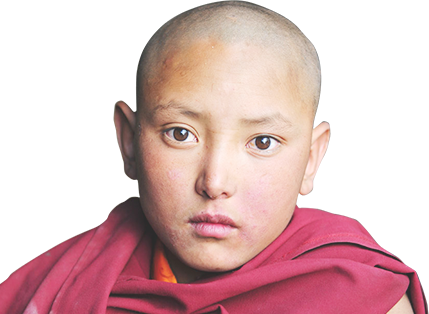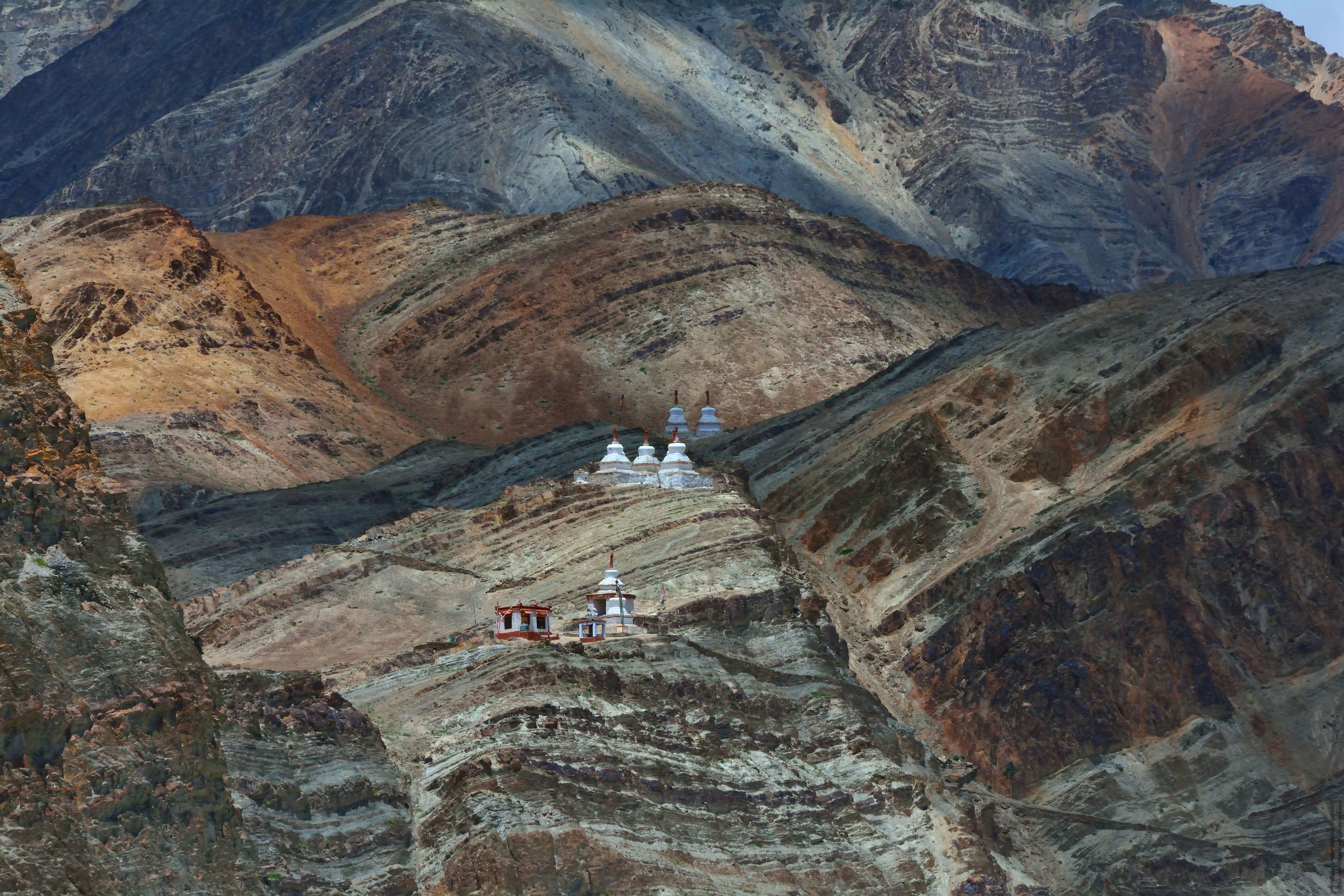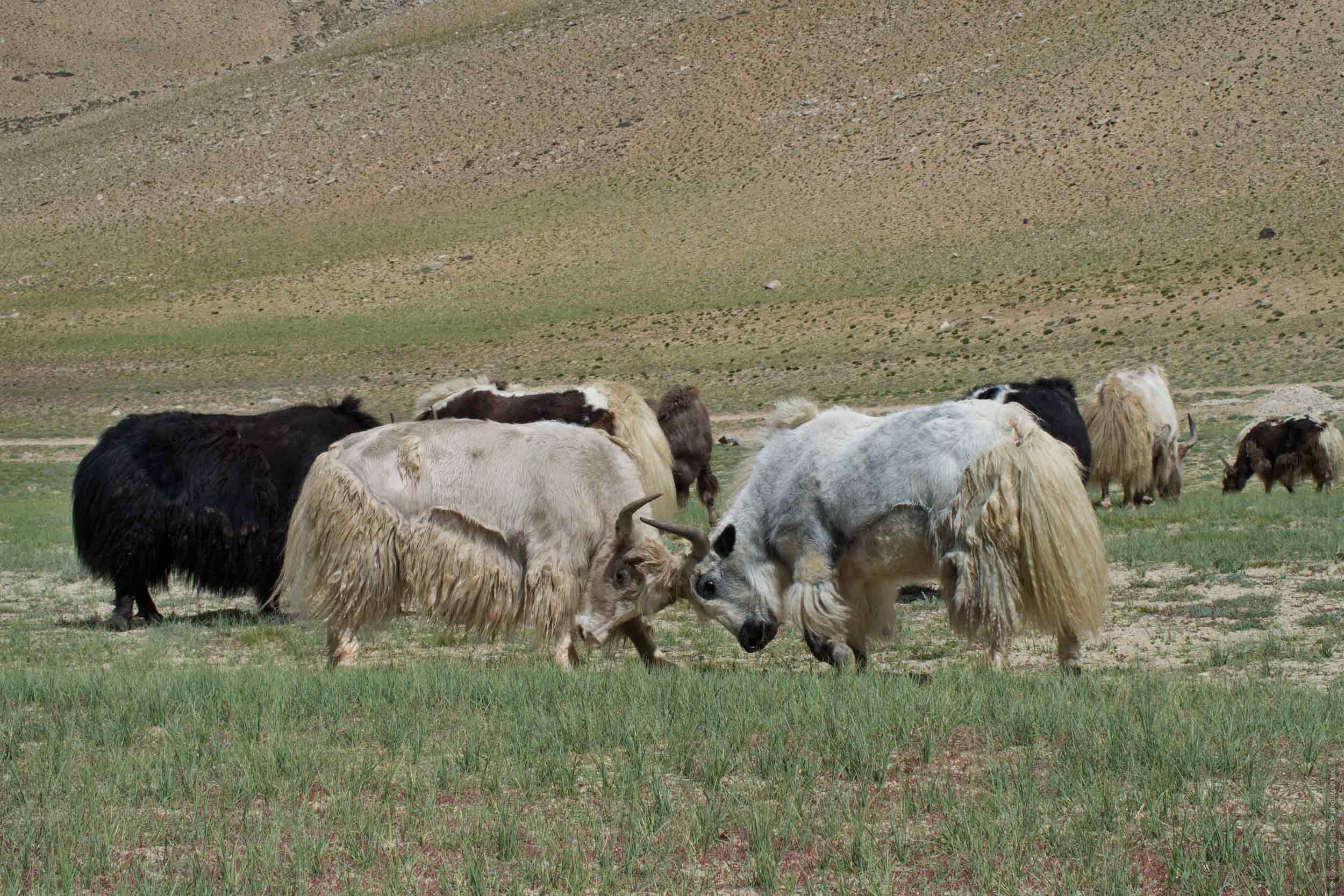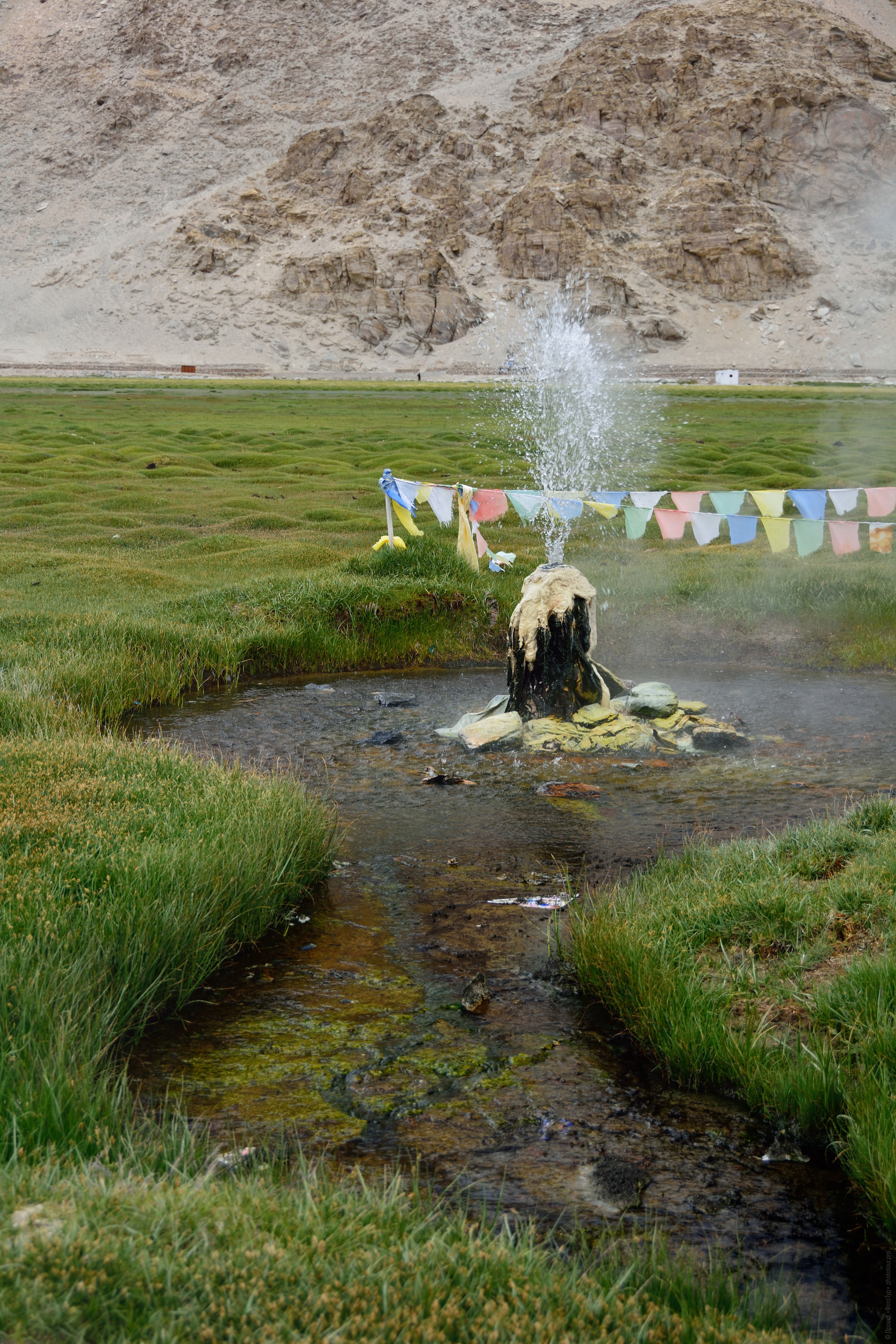The Booking of your participation in any journey takes place in three stages:
First step: Filling the application form for participation in the tour. Be sure to include your full name, We work officially and all accounts are registered. Please write your contact so that we have the communication wit you. After your application come to our website - the site administrator will send you a bill at your name for a advance of the tour. Maximum response time: 6 hours. Usually responsible for 1 hour.
Second stage: The reservation to participate in any tour takes place when you make the advance payment of 30% of the tour price to the account of an Indian travel company INCREDIBLE HIMALAYA. The advance is transferred via bank payment systems in any bank, account details will be sent by the administrator to e-mail of participants after getting the application form for participation.
ATTENTION Booking the tour takes place only when the advance payment transferred. If, after receiving of the invoice for advance payment, you do not make a payment within three working days, your application form for participation is automatically canceled by site. If you still want to participate in the tour, you have to apply the form again. When we receive an advance on our bank account we sent payment receipts confirming your participation, as well as a contract for the provision of travel services on this tour. The administrator sends you the electronic copies of receipts and contracts with digital signature and seal by e-mail and if necessary - to the postal address - the original documents. The remaining amount is payable as ayou arrive at the beginning of the trip, in India.
The third stage: Preparing for the journey. We also have a verbal communication on Skype with members of our travels. 2 weeks before the tour we gather the whole group in Skype and discuss preparations for the journey. Also welcome verbal individual consultations on Skype, it helps us to answer all your questions maximized. Because the most of the year we are in India, the main communication with us is Skype.
Attention! You don't need to register on our site to join the tour. If you are unable to fill the application form, please just send your application in letter (free form) - by mail: [email protected]
Attention! If you have not received a response to your letter within 6 hours (maximum response time for a request), please look at the spam folder. Perhaps, our letter got there by mistake. We always reply to requests in a maximally short period of time.
Ladakh Ladies Tour with Marina Klimchuk: Ladakh Defile.
Day 1, August 31: Delhi - Leh (flight). Acclimatization to height. Walking through the Old Town.
Day 2, September 1: Leh - Monastery Tiksey Gonpa - White Stupas of Naropa and Shea Gonpa. Familiarity with the culture of Tibetan Buddhism.
Day 3, September 2: Leh - Maroon gorge, Goat and Sheep farm. Going for a coat.
Day 4, September 3: Lech. Tibetan Medicine Clinic Men Dze Khang. Workshops of the Mothers Center of Ladakh.
Day 5, September 4: Leh - Basgo Monastery - Likir Monastery - Hemis Shukpachan village. Acquaintance with life and life of Ladakh women.
Day 6, September 5: Hemis Shukpachan - Domkar, Da Hanu Gorge. Picnic with Aryan women. Evening walk through the village.
Day 7, September 6: First day of the felting workshop. Master class on national Tibetan clothing and national decorations.
Day 8, September 7: Second day of the felting workshop. In the afternoon visit the village of Bima.
Day 9, September 8: The third day of the workshop on felting. In the afternoon - a master class on cooking national Ladakh cuisine.
Day 10, September 9: Moon Land, Lamayuru, photographing the costumes of Ladakhi Defile. Return to Leh.
Day 11, September 10: Leh - Lake Tso Moriri. Acquaintance with the life of women of nomads Chong Pa.
Day 12, September 11: Tso Moriri Lake. Visit the settlements of nomads Chong Pa and herds of Tibetan yaks. Photographing suits Ladakhskoy Defile.
Day 13, September 12: Lake Tso Moriri - Lake Tso Kar, photographing the costumes of Ladakh Defile on Tso Kar Lake. Return to Leh.
Day 14, September 13: Free day in Leh: sum up and buy stocks of wool.
Day 15, September 14: Transfer to Leh airport. Flight Leh - Delhi. Homecoming.
Attention!
The cost of the tour with a reservation before May 1 - 1377 USD,
The cost of the tour when booking after May 1 - 1430 USD.
Reservation of places for participation in the Ladakh Defile Women's Tour takes place when the Indian travel company NCREDIBLE HIMALAYA PRIVATE LIMITED makes an advance payment in the amount of $ 240.
The advance payment is transferred by the tour participant using payment banking systems in any bank, the details of the current account are sent by the administrator to the participant’s mail after receiving the application for participation in the trip.
Advance payment can be made: Payment Methods.
When making an advance, the participant is sent a payment receipt and an agreement on the provision of travel services, confirming the payment of money and booking your participation in the tour.
The remaining amount is paid by the participant upon arrival at the starting point of the tour, in this case upon arrival in Leh, Ladakh.
1. Transfers from / to the airport to the hotel in Leh.
2. Movement along the entire route (from the ramp to the ramp) in comfortable cars.
3. Accommodation in double rooms in hotels and guest houses along the route of the tour.
Residing in a single room is possible, surcharge $ 317 for the entire route.
4. Information support by the organizers of the PhotoTour Project from the beginning to the end of the tour.
5. Guided tour of the English-speaking guides of the PhotoTour Project.
6. Lecture-introduction of Ilona Kryzhanovskaya into the culture of basic values of Tibetan Buddhism: The wheel of Samsara is an instruction for life.
7. Lecture-introduction of Ilona Kryzhanovskaya into the culture of Ladakhi matriarchy: the place of a woman in the culture of Tibetan Buddhism.
8. Lectures Kakar Lonpo (English): The role and place of women in the Tibetan family, Basics of Tibetan cuisine, Tibetan clothing and jewelry.
9. Practical workshops:
Cooking Tibetan cuisine, Tibetan clothing and jewelry, Introduction to basic energy practices.
10. 3-day practical seminar of Marina Klimchuk: Basics of live creativity in creating a holistic image in clothes and costume.
11. Consultation and pulse diagnosis at the Men-Dze-Khang Institute of Tibetan Medicine.
12. Picnic with Aryan women in the village of Domkar.
13. One professional portrait in national Aryan clothing and decorations in electronic form.
14. One or two photos from the Ladakhian Defile for each participant in electronic form.
15. All taxes and fees on the tour route.
1. Flight to Delhi airport from the country of residence and back.
ATTENTION!
Air travel from Europe to Delhi and back is very inexpensive:
in May and June, these flights will cost about $ 300 in both directions.
2. Flight Delhi - Leh - Delhi. Approximate airfare from $ 80 to $ 120.
Attention!
These tickets are redeemed immediately after making an advance for participation in the trip:
PhotoTour Project administrators assist tour participants in purchasing these air tickets at the lowest cost.
It should also be noted that the earlier tickets are bought, the cheaper they are.
3. Tourist e-visa (e-visa) to India $ 100, issued online 7 days before arrival in India.
Information on obtaining a tourist visa to India.
4. Entrance fees to monasteries, about $ 10 for all time.
5. The cost of permits to the closed border zones of Ladakh (Tso Moriri lake, Aryan villages of Da Hanu), $ 20 per permit.
6. Meals during the tour: about $ 160 for the entire trip.
7. Medical insurance: issued by each participant individually.
8. Mandatory tips for drivers and English-speaking tour guide at the rate of $ 1 per day.
9. All that is not listed in the list "Included in the tour price".
The Ladakh Defile Tour is designed for young ladies from the world.
ATTENTION!
This tour has no special requirements for physical condition and health.
You should also not worry about high-altitude acclimatization:
we can acclimatize and, almost all of our tourists, easily tolerate the climate and altitude of Ladakh.
The tour has age restrictions: from 15 years to 70 years.
RECORDING FOR PARTICIPATION IN THE WOMEN'S TOUR IN LADAKHU IS POSSIBLE TO AUGUST 1, 2019.
But entry into the tour can be stopped earlier - as soon as a group of 12 people is typed.
The number of participants in the tour is fixed.
If you want to go to Ladakhian Defile, please book in advance.
The conditions on the tour are as comfortable as possible for Ladakh:
- in Leh: a cozy warm hotel with hot water, with bathroom and toilet in the room, wi-fi in the room.
- in the village of Hemis Shukpachan: a cozy guest house, showers and toilets in each room.
- in the village of Donkar: a new comfortable magnificent hotel, showers and toilets in each room, Italian plumbing, hot water, elegant national cuisine, eco-location of the hotel.
- in the village of Karzok, Lake Tso Moriri: a luxury hotel overlooking the lake, toilet and shower in the room, hot water in the evening, occasionally there is wi-fi in the room.
For those who want to ask questions about the organization and participation in the Ladakh Women's Tour, please contact us:
Phones for communication:
+7 968 007 74 47 (Russia) - Ilona Kryzhanovskaya, Project Manager of PhotoTour, India.
+ 91 94 19 274 735 (India) - Ilona Kryzhanovskaya, Project Manager of PhotoTour, India.
+ 91 95 96 796 372 (WhatsApp, Vatsap) - Project PhotoTour, India.
+ 38 098 08 98 228 (Viber) - Marina Klimchuk, Kiev, Ukraine.
skype:
il-il-il (or search by email [email protected]) - Ilona Kryzhanovskaya, Project Manager of PhotoTour.
e-mail:
[email protected] - Ilona Kryzhanovskaya, Project Manager of PhotoTour
[email protected] - Marina Klimchuk, Master of the tour Ladakh Defile.
A team of organizers works on the Ladakhu Women's Tour:
Marina Klimchuk, Master of Tour Ladakh Defile.
Ilona Kryzhanovskaya - Project Manager PhotoTour, ethnographer, psychologist, professional photographer.
Kakar Lonpo is co-owner of the Incredible Himalaya travel company, an expert on ethno-tourism in Ladakh.
Sonam Rinchen is a partner and co-founder of PhotoTour Project.
Otzer Rinchen - Head of the team of Project Photo Tour guides.
Nina Lozenko - Director-Administrator of the PhotoTour Project.
Our local Ladakh English-speaking culture guides, PhotoTour Project team.
A team of driver guides throughout the tour.
For participants of Ladakh Defile we recommend for mandatory reading,
There are answers to all questions on the conditions of the tour and preparation for it:
Recommendations and rules for travelers and travelers in Ladakh, Zanskar and Spiti Valley (Little Tibet).
Like all our women's tours, this tour is also another experiment, another creative workshop.
And this time it is aimed at a very narrow audience - at the young ladies who roll and create clothes made of wool).
By the way, we will have not just a lot of wool, but a lot and very different:
Sheep, goats — Pashmina, Pashmina, and Yaks — we will touch little animals and choose camels — true alpine warming camels.
And at the same time we will learn to spin such wool, weave, however - we will learn a lot of things, for more details - in the description of the tour.
Who is this tour for?
This tour is for women who have clearly defined goals that have already achieved a lot, but have a desire to develop further.
For those who are impregnated and live creativity.
Who paused the rest in search of themselves and was a little confused.
This trip will be the door that will take you to a new level of knowledge.
For those who want to radically change their lives.
To be renewed and filled with the air of freedom by an endless stream of creative ideas, immense imagination, to expand the scope of perception, knowledge of the world and yourself.
Who leads this tour?
Master of the felting tour - Marina Klimchuk:
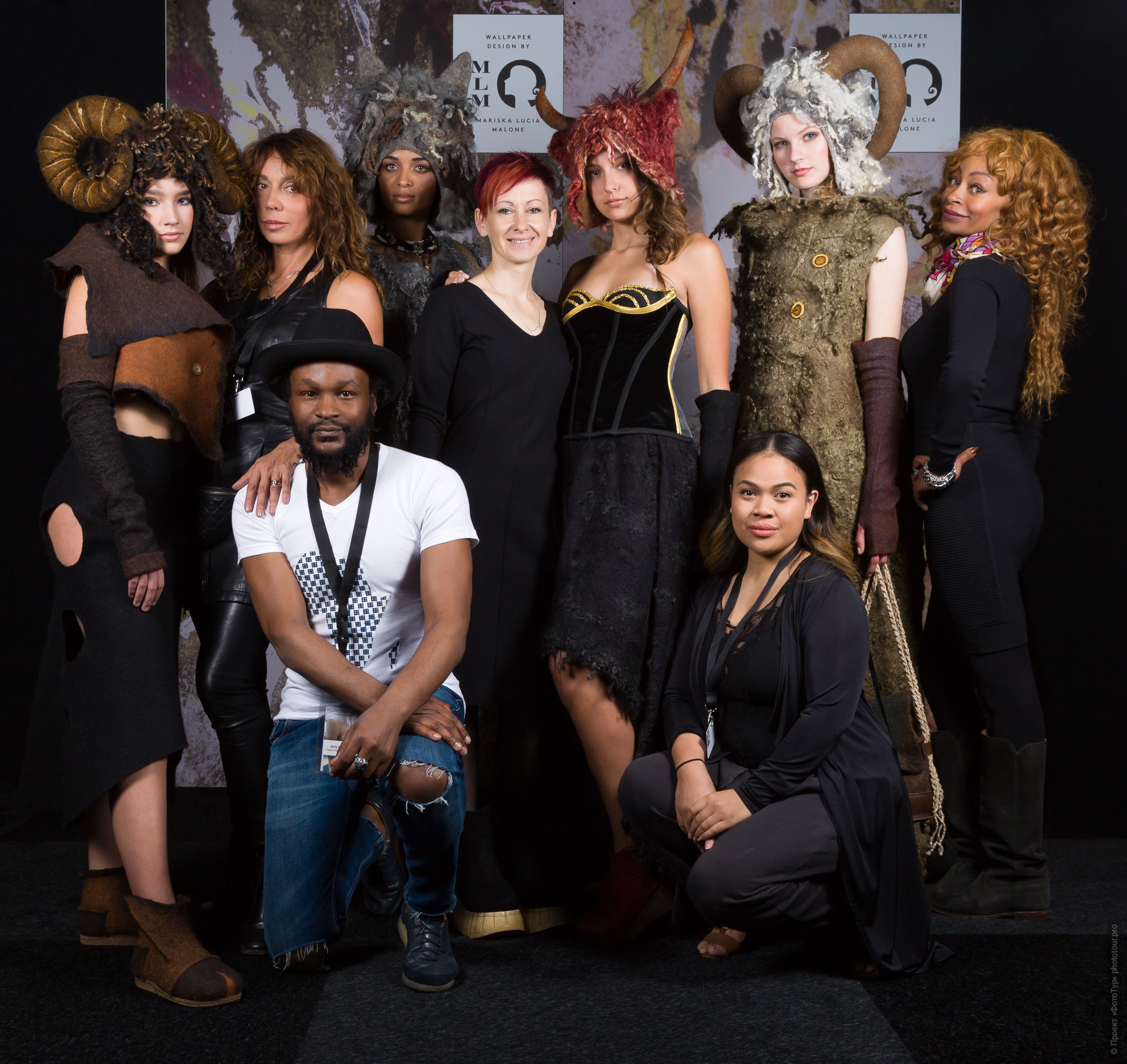
Did you recognize Marina?
For those who have the first acquaintance with the Master, then Marina is in the very center, so small in appearance.
But only in appearance.
Around Marina - models are all in her works).
Marina Klimchuk is the creator of the author's technology of felting and assembling felted shoes.
Her work has grown from hobbies on maternity leave to professional products for designer shows and creating her own collection!
A large number of successful masters today are students and pupils of Marina Klimchuk.
For over 7 years, the master has been sharing secrets and tricks.
During this time, Marina Klimchuk conducted hundreds of full-time master classes in Russia, Belarus, Germany, Poland, Holland and Lithuania.
Marina Klimchuk’s training video courses have been translated into English and are popular not only in the CIS countries and Europe, but also far beyond the continent - in the USA, Canada, and Latin America.
More information about the works of the master can be found here:
Design defile of Marina Klimchuk.
Marina Klimchuk at the Fair of Masters
Shoe designer Marina Klimchuk
Scream
Marina Klimchuk with the Masquerade collection at the exhibition "New Life of Traditions IX"
Marina Klimchuk and her collection "My Spring"
Marina Klimchuk, defile in Almre, Holland.
The idea of the part of the tour, which is dedicated to felting:
The practical course of our tour will be entirely and entirely devoted to felting.
It will be necessary to prepare for the course in advance, to create your own creative image and then, at the place of the tour, supplement it with details, local flavor in Ladakh.
Bring your stylish Tibetan outfit to the perfect lines, inspired by staying in the perfect world of beauty and harmony.
In the days of practical felting, we will test the wool of local animals: sheep, yaks, goats, camels.
We will get acquainted with the traditional centuries-old experience of felting craft in Tibet and can be applied in the future in our art projects.
The highlight of the felting course in Tibet will be a professional photo shoot, a defile of wonderful costumes. Images that will be saturated with special spirituality. Things that will bring further life path: good luck, confidence, harmony and saturate the everyday routine with colors.
A photo session in Tibet from Ilona Kryzhanovskaya, a professional photographer, these photos will be for you a portfolio and another stage in the development of your creative path, the conquest of another peak.
Also, a Ladakh pair of young ladies paired with Marina:
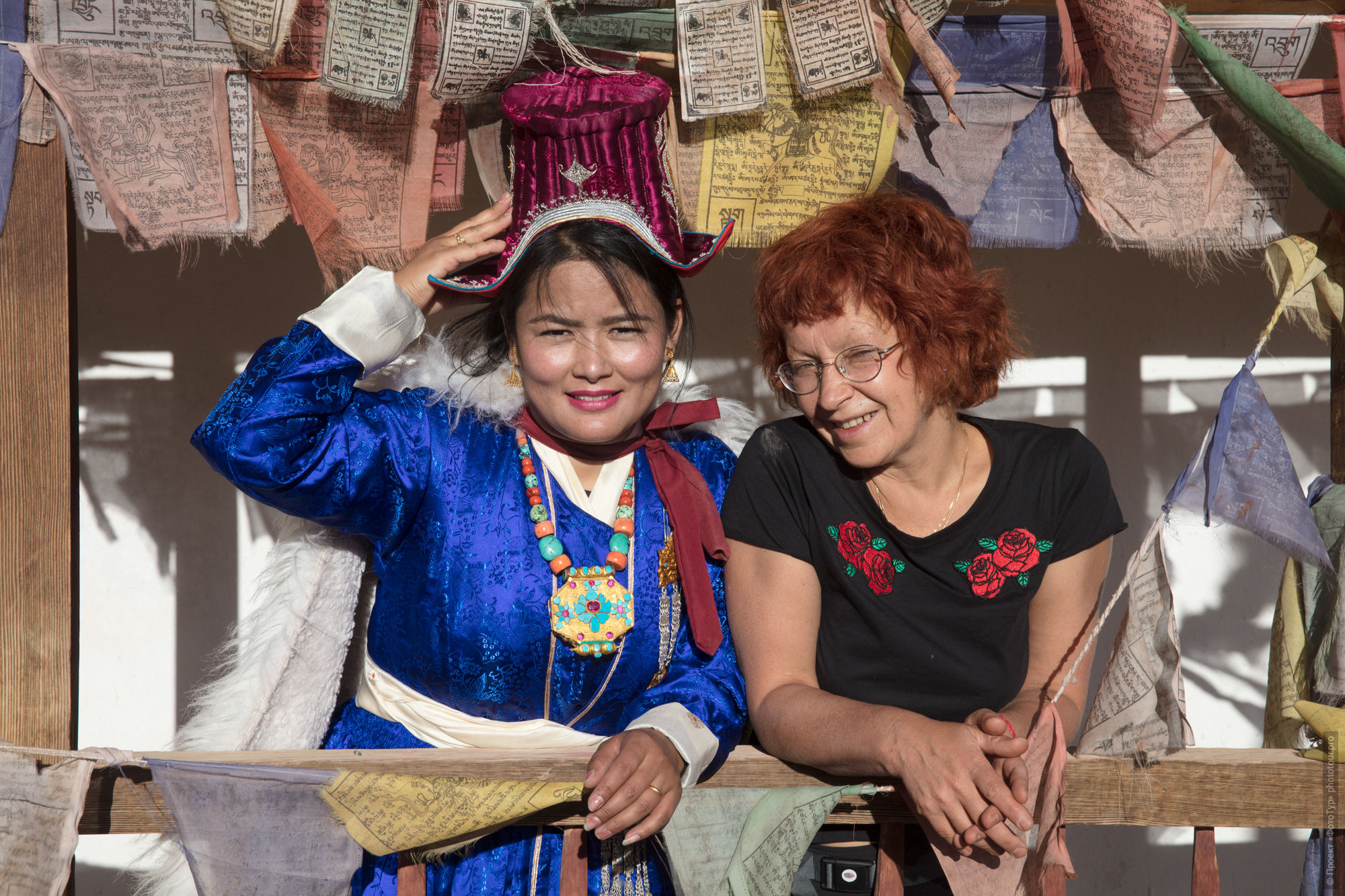
On the right is Ilona Kryzhanovskaya, head of the travel company Project PhotoTour, ethnographer, photographer, Buddhologist.
Left - Kakar Lonpo, co-founder of travel companies Project PhotoTour, ecotourism and ecology of life.
By the way, photos of Ilona Kryzhanovskaya and Ladakh (not only Ladakh) can be viewed here:
Ilona Kryzhanovskaya 500.
WE WILL BE HAPPY TOGETHER TO GO THIS TOUR TO LADAKH!
All photos in the tour description, taken by us during our travels in Ladakh and these are the places that you really will see and where you will visit, taking into account the schedule of the tour, weather, etc.
Photos are clickable to large size, just click on the photo and it will open in a new window.
In the description of each day of the tour in the title is given the approximate mileage for each day and the height of the visited places.
Before going into a detailed description of each day of our tour, I want to say two things:
1. Ladakh, Little Tibet is the only territory in our plan where the oldest culture of Tibetan Buddhism has been preserved in its original form.
Here everything is really preserved in its original form:
and the female role, as in the old days, remains leading in society, in fact it is the territory of a soft matriarchy.
This is a centuries-old culture with the cult of Tara, the Savior of the World, born of the tears of Avalokiteshvara (Buddha of Compassion), at the moment when he mourned the sufferings of the world.
A lotus rose from a fallen tear, and Tara was born from him, becoming his wife.
This metaphor reflects the actual way of life and the role of women in the culture of Ladakh.
And European women have something to take from relationships, perceptions of the world and life of a Tibetan woman, this knowledge really enriches and makes life, relations with men completely different, another level.
2. And Ladakh is just amazing beautiful atmospheric places.
And these are very strong places in energy:
It was not by chance that scholars and esoterics of all times strove here
I would like to show this atmosphere of the places where our tour takes place and we will do it with the help of a small amateur film shot by our friend and tourist Sergey Pobegaev in 2014 during a tour of the highland lakes:
Sergey Pobegaev: LADAKH.
And now - a detailed schedule of our tour.
Day 1, August 31: Delhi - Leh. Delhi - Leh (airfare). Adaptation day. Acclimatization. Walk along Lech, height 3 600 m.
Arrival at New Delhi International Airport (India) from the country of residence.
Visa control, we get luggage and move to the departure terminal of local airlines.
This is a common practice on our tours in Ladakh:
flights where members of our tours arrive at Delhi Airport usually arrive at terminal D3 from 2 to 5 am,
Participants immediately go to terminals D1, D2 or D3 and fly to Lech on one of the morning flights.
Flights for Delhi - Leh take so that the time reserve between the external and internal flights is at least 3-4 hours.
Flight to Leh, 1 hour 20 minutes.
The Delhi-Leh air flight itself is a fascinating sight - it is impossible to break away, the plane flies over the beautiful peaks of the Himalayas.
It is highly recommended that you purchase a ticket immediately book a place near the windows.
For those who want to take pictures of the mountain ranges from the plane, the most successful places will be from 25F to 30F and from 25A to 30A.
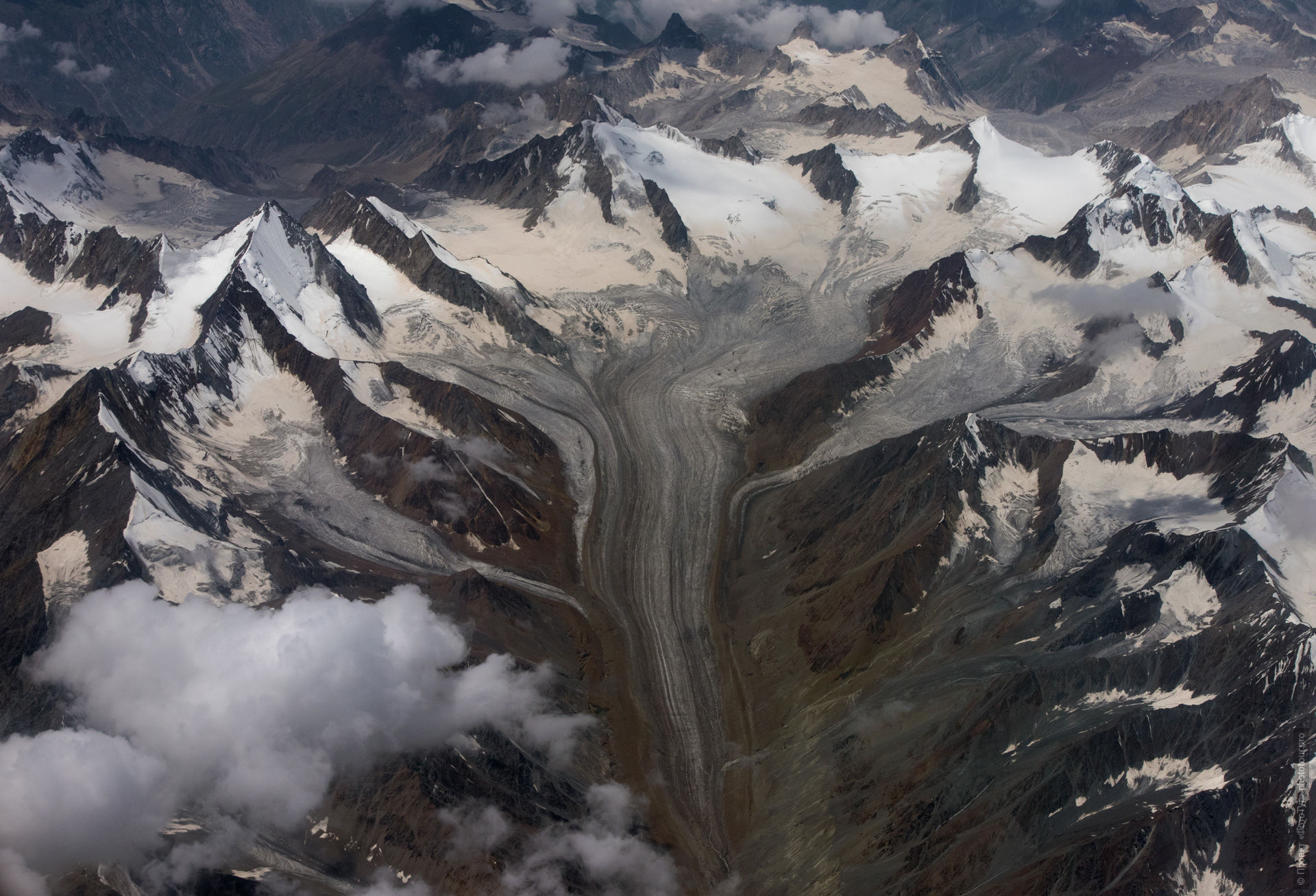
The plane literally sneaks and moves along the gorge in the middle of the mountain ranges, the mountain ranges are lying below by pictures.
You will see massive glaciers, deep mountain valleys, turquoise ribbons of rivers, lakes, colorful highlands of deserts with the strings of the Leh-Manal highway — all those places we will visit during our trip.
You will see a lot of things, but it is very important to reserve a place in advance near the porthole:
when registering at the airport such places will not be.
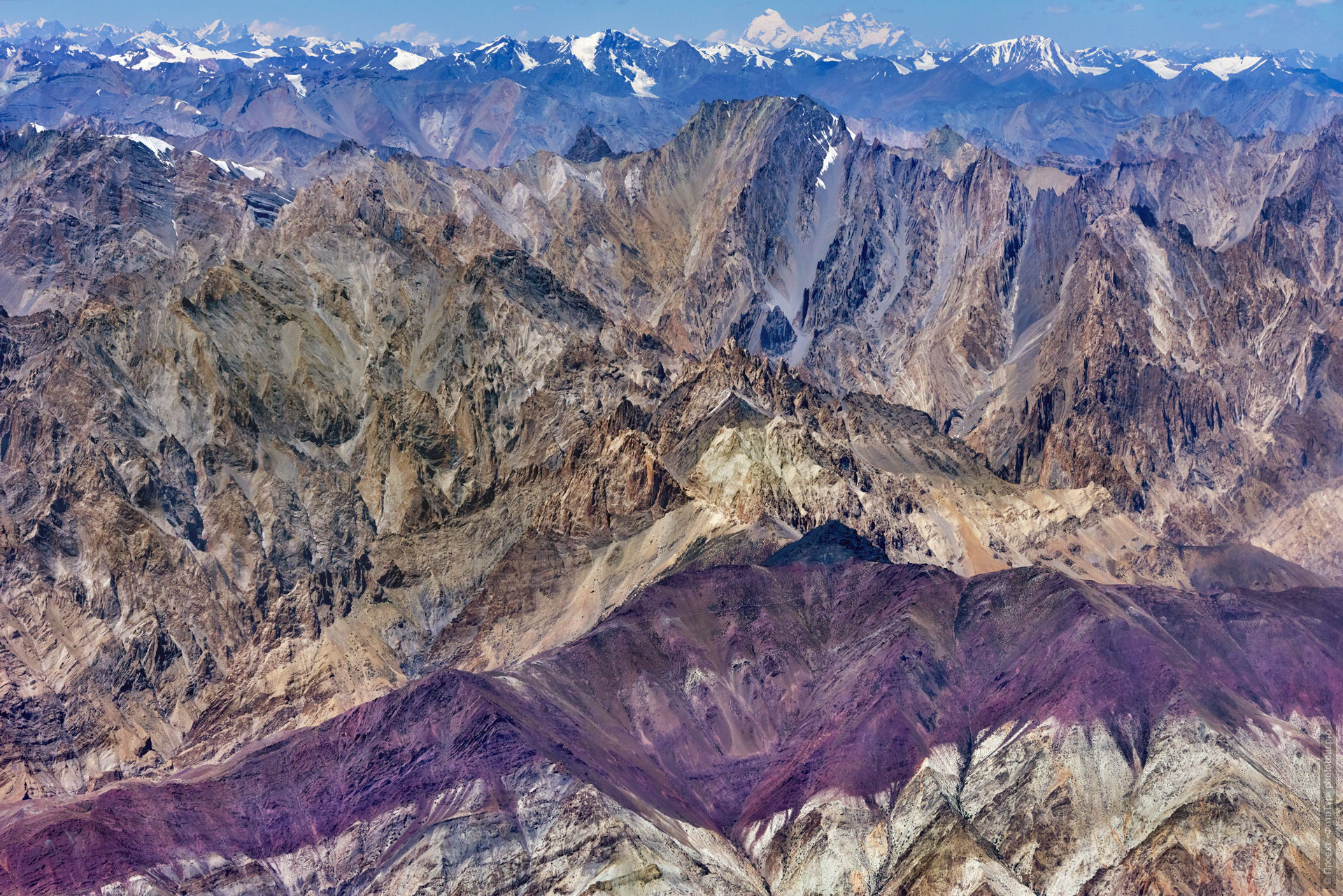
We arrive in Ladakh, the plane makes a beautiful turn over the valley of the Indus River, flies over the Spituk Gonpa Buddhist monastery and lands at the only airport in the valley - in Leh city.
Here it is, our runway.
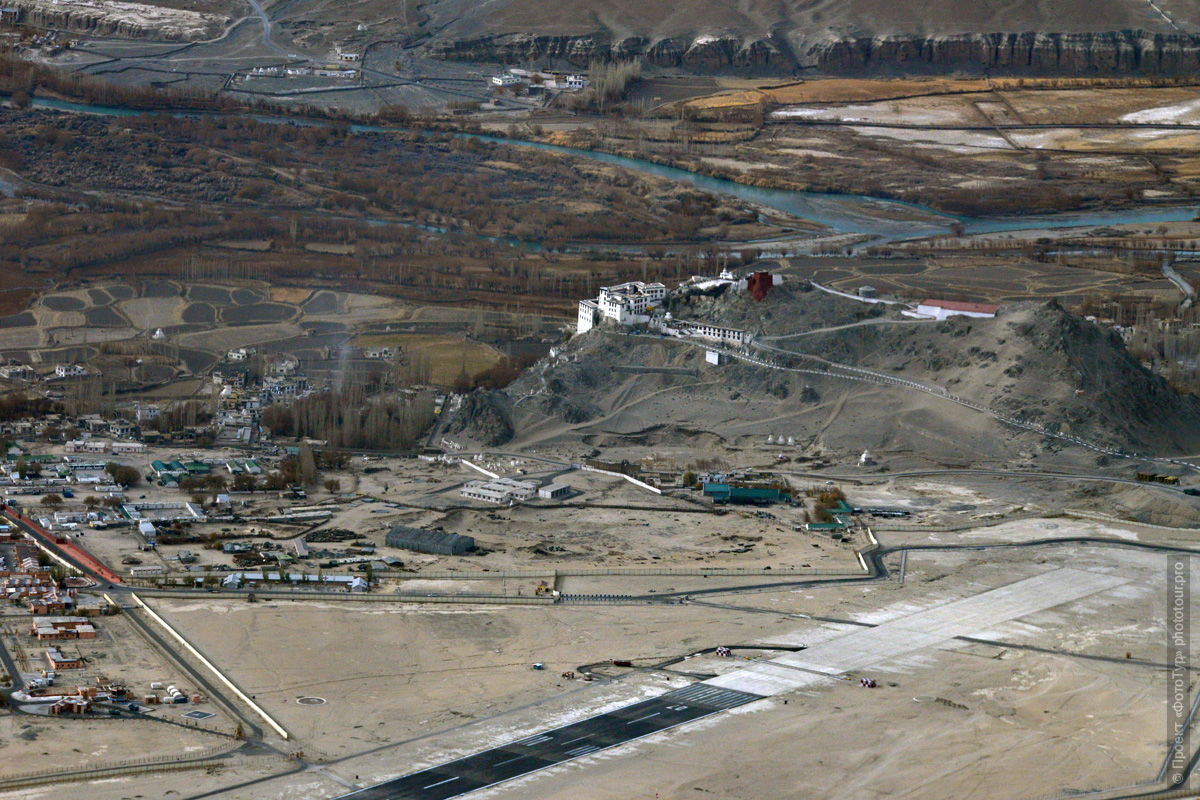
Arrival in Leh: at the airport Leh immediately at the exit of the participants is met by a guide with a cheerful sign PHOTOTOUR.
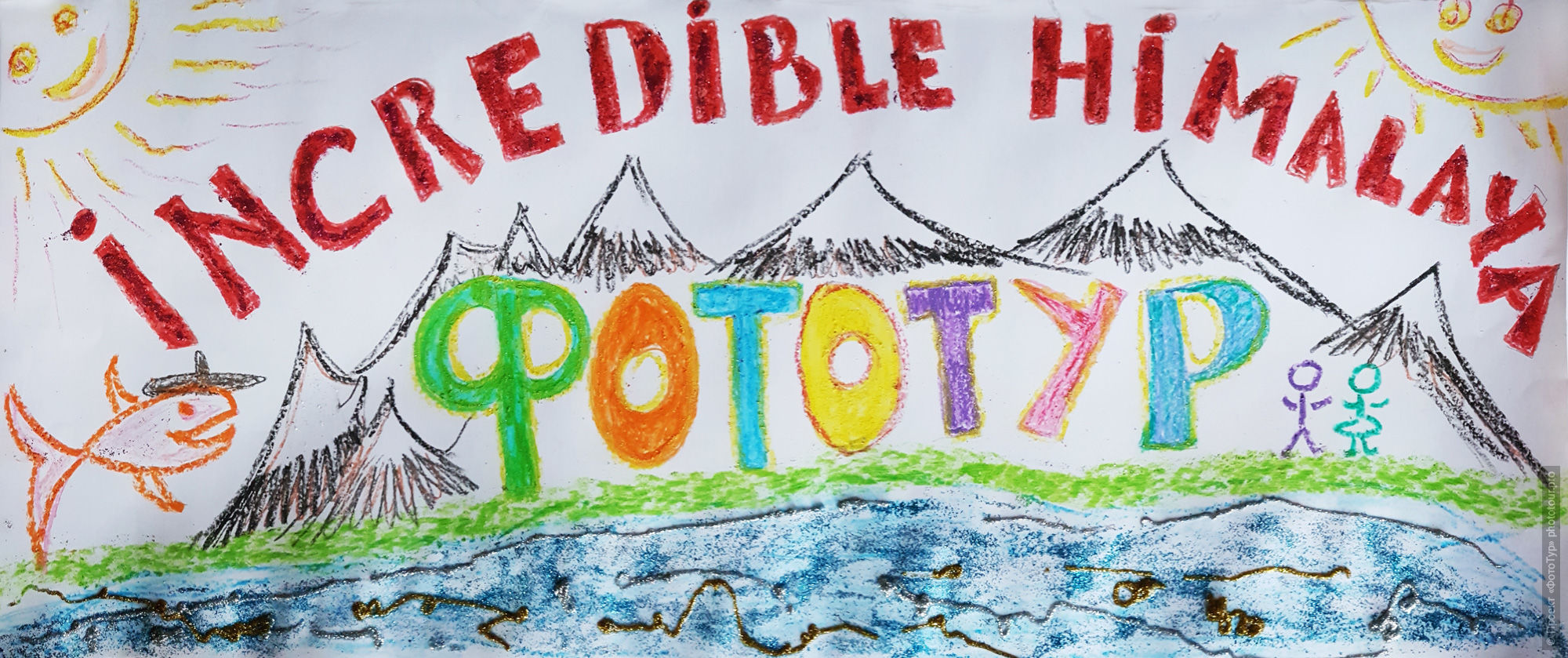
Transfer to the hotel, breakfast.
Leh is at an altitude of 3600 m.
And on the first day of the tour it is very important for the participants to undergo the correct altitude acclimatization:
We pass instruction on acclimatization, drink a lot of liquid, the first hours on arrival we rest in the hotel.
After an acclimatization holiday at the hotel, we go on an unhurried adaptation walk in the center of Lech to the Main Market:
We get acquainted with the infrastructure of the city, walking along the main street of the city.

We’ll finish our walk in the wonderful Penguin cafe-restaurant (yes, yes - Penguin), where our first dinner will be held in Leh with delicious fresh natural fresh juice.
Hotel in Leh.
Day 2, September 1: Leh - Monastery Tiksey Gonpa - White Stupas of Naropa and Shea Gonpa. Acquaintance with the culture of Tibetan Buddhism, about 40 km, elevation 3,600 m.
Our first day in Ladakh and we will spend this day, getting acquainted with the culture of Tibetan Buddhism.
In the morning we go to the Buddhist monastery Tiksi Gonpa.
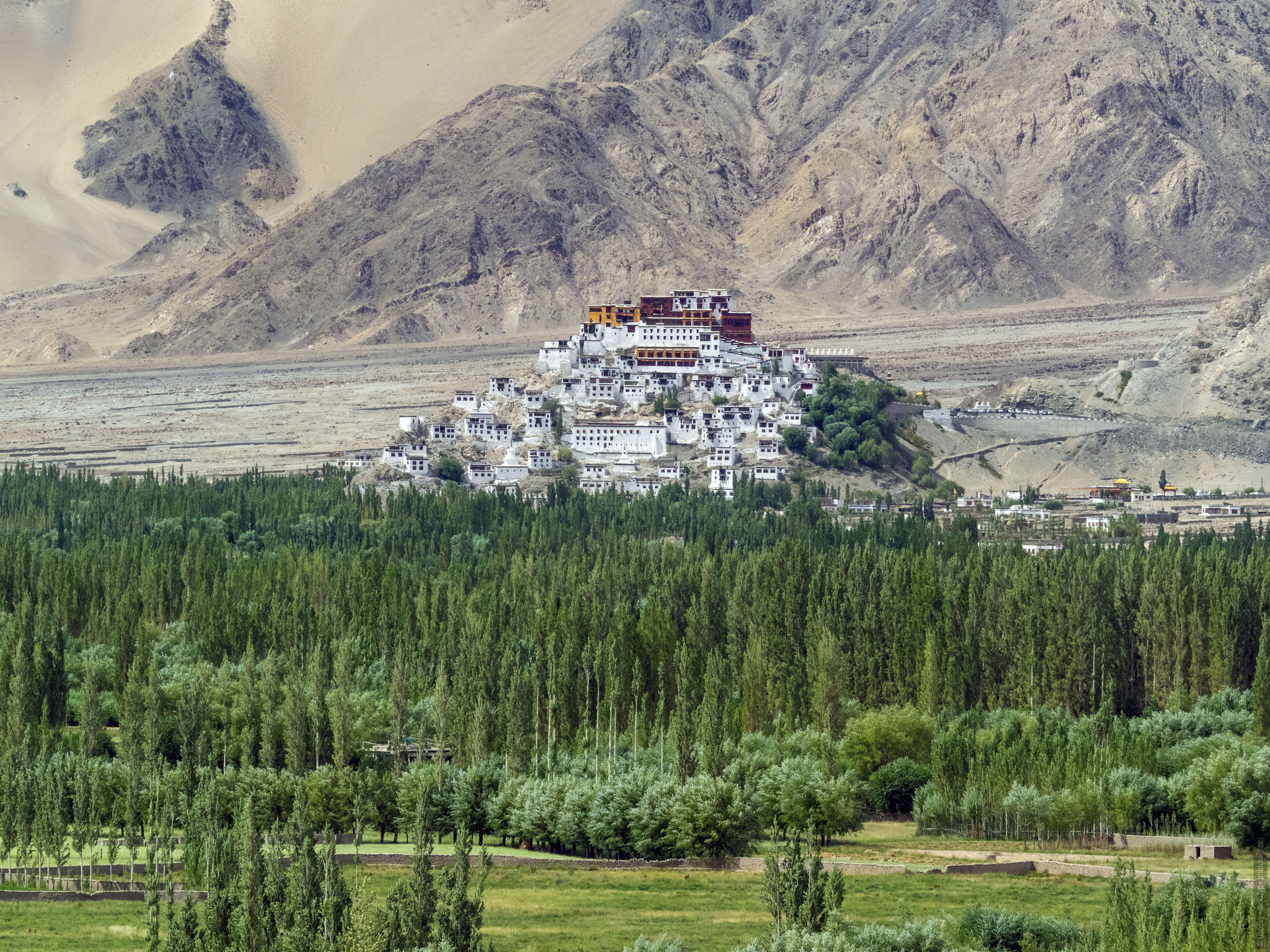
The monastery itself is huge - the largest in Ladakh, in fact, the city-monastery, with adjacent villages, surrounded by ancient stupas, houses of lamas, monastic schools.
Monastery Tiksi Gonpa consists of twelve levels and ten temples, towering on the slopes of the mountain.
At the very top are the private apartments of Rinpoche Gonpa.
Below the monastery on the mountain slopes are located the chapels and the houses of the monks.
The walls of the Tiksi Gonpa are covered with astonishing ancient frescoes, for example, with scenes of sacrifices.

It will be interesting for us to visit the monastery for two reasons:
1. Here we will see for the first time the Wheel of Samsara - essentially an instruction for life in the culture of Tibetan Buddhism and we will try to thoroughly understand this instruction:

2. We will also visit Thixi Gonpa Convent and get acquainted with the life of Nanari, Ladakh women who have become monastic.
And just walk around the city-monastery among the white stupas:
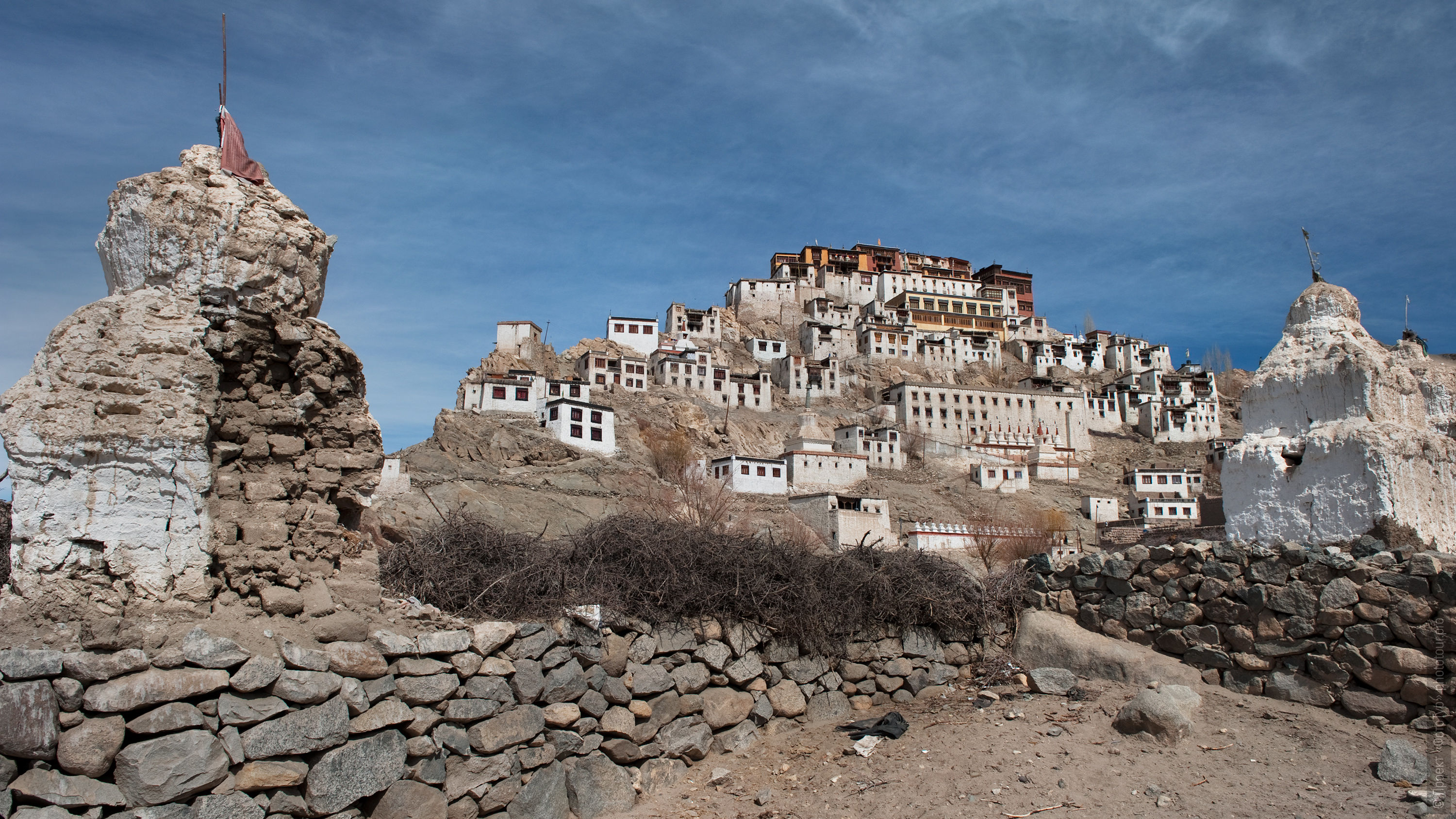
We have lunch at a restaurant at the Buddhist monastery of Tiksi and go to a very clean and bright place - to the White Buddhist Stupas, where the teacher Naropa and the Buddhist monastery Shay Gonpa meditated.
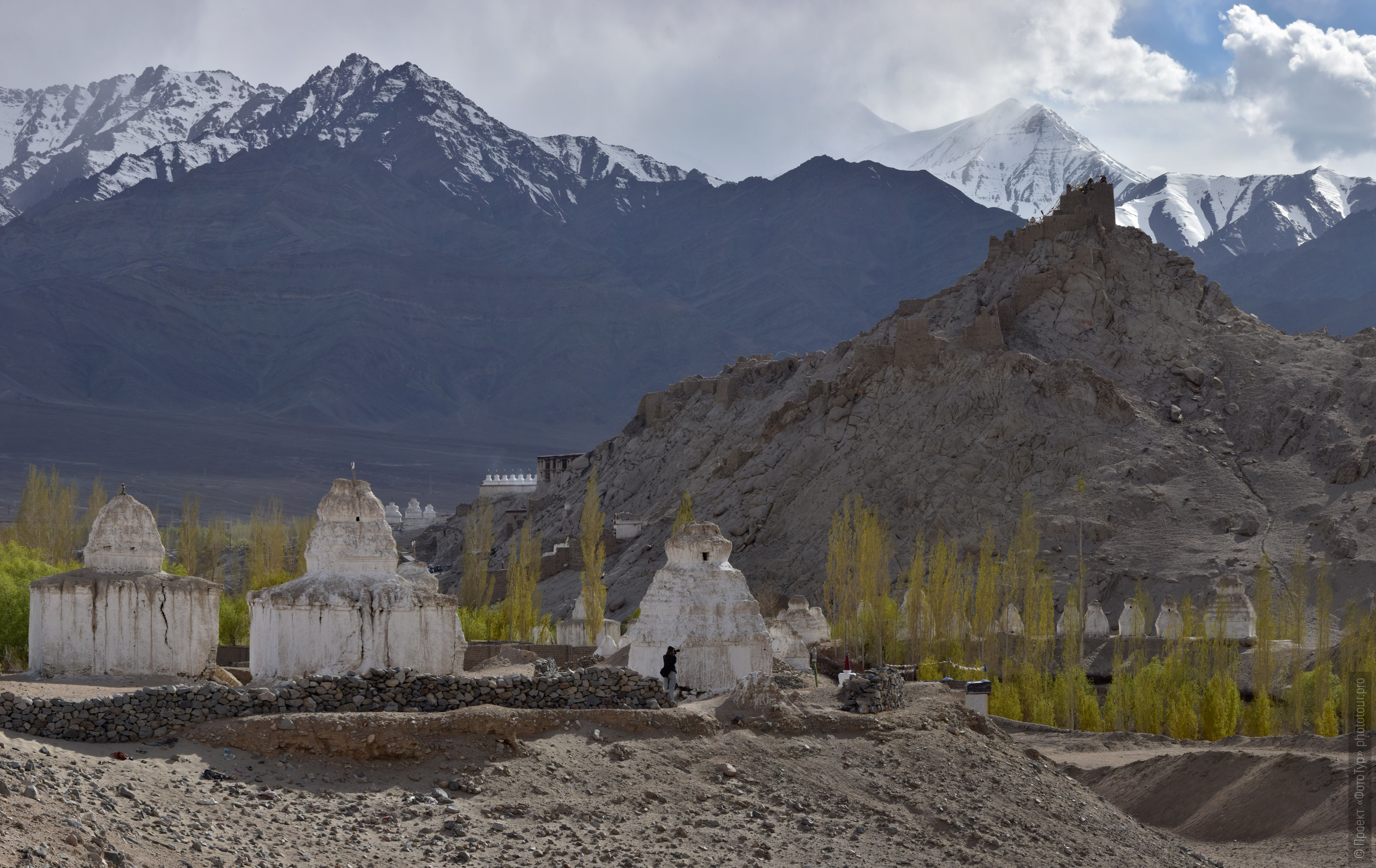
The place is of extraordinary beauty:
The palace and gompa (monastery) were built in 1650 by the Tibetan king Deldan Namgyal.
The palace houses the largest chorten (a type of stupa) in Ladakh, the top of which is made of pure gold.
In the 19th century, the royal family moved to the palace in Stoke.
But the field, the space with stupas existed here from much more ancient times - 10 centuries ago the Great Tibetan Teacher - Naropa meditated here.

The place is absolutely extraordinary - here space and Time are completely lost, here the dust is gilded in the sunset rays, here you can wander for an infinitely long time in peace and quiet.
And, by the way, from here, there is a magnificent view of Tiksi Gonpa, where we were in the morning.
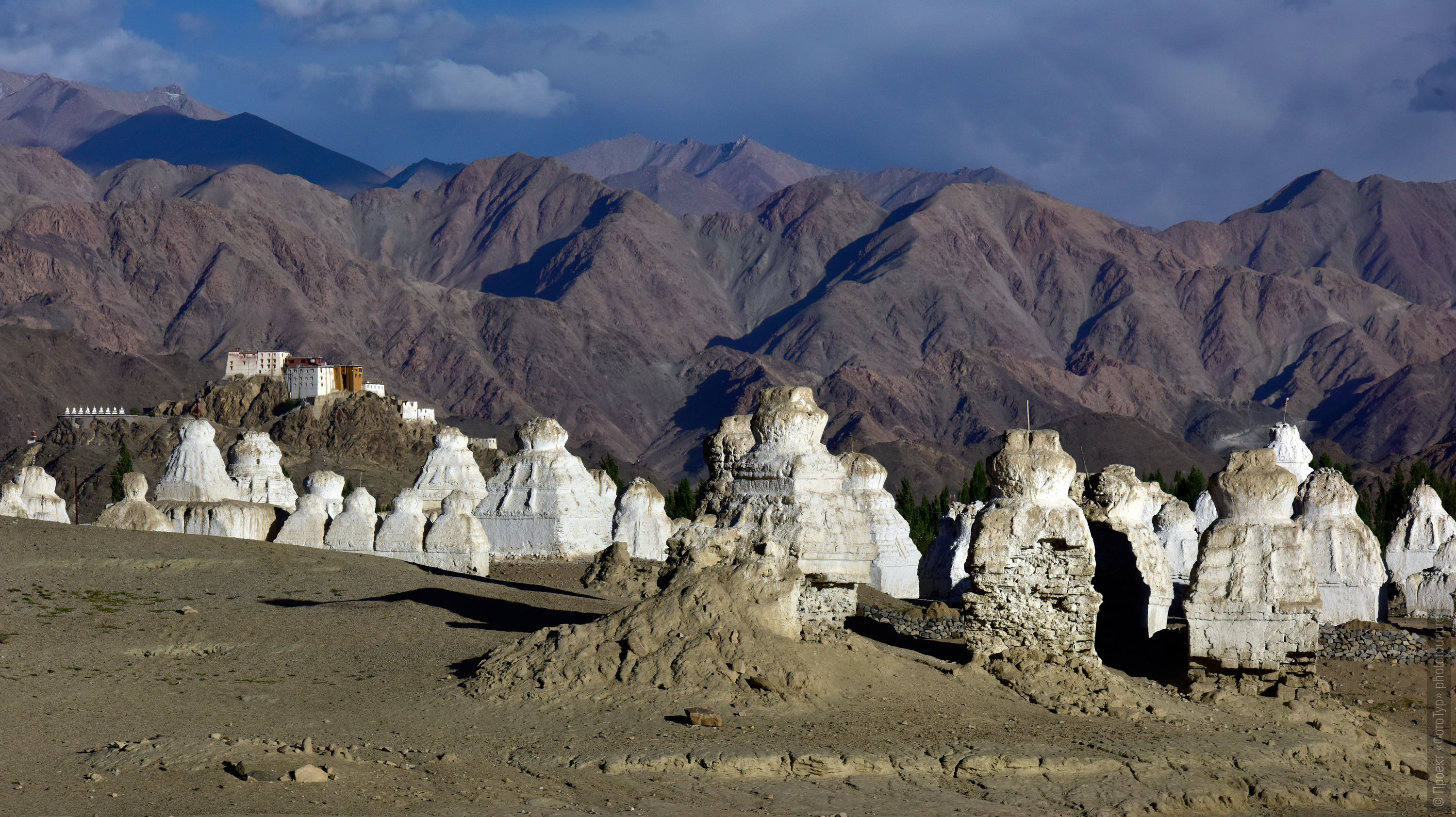
In the evening we return to Leh and after a cozy dinner we talk about our workshop on felting and photos of Ladakh Defile.
Hotel in Leh.
Day 3, September 2: Leh - Maroon gorge, Goat and Sheep farm. A trip for wool, about 120 km, altitude 3,600 - 4,000 m.
Today, our first purely professional outing - we go to a goat and sheep farm in the Burgundy canyon here to such wonderful creatures:
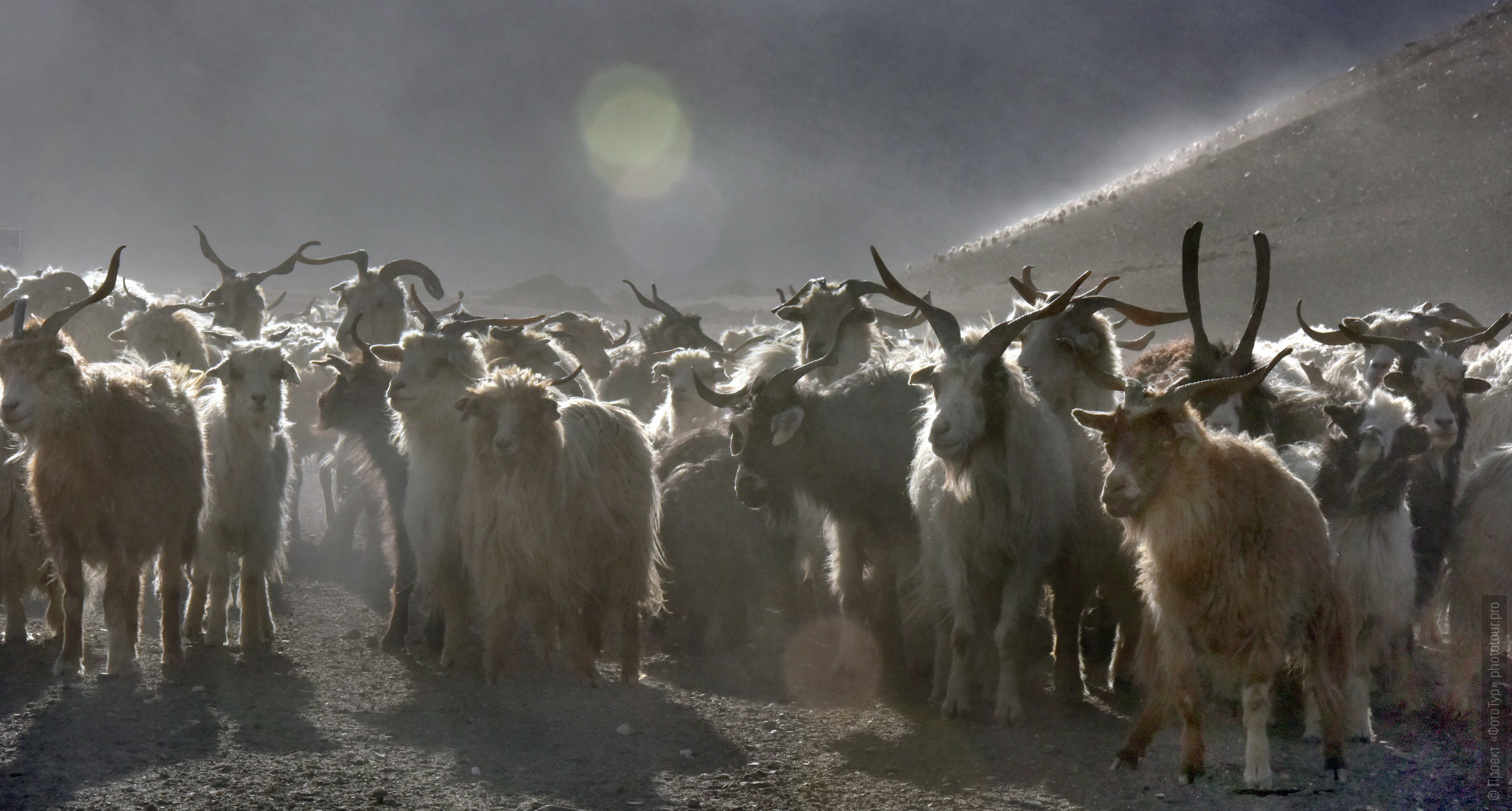
We will get acquainted with these marvelous animals, so that they are bred and grazed in Ladakh, how they are looked after when they collect wool.
We also purchase our first batches of felting material right there.
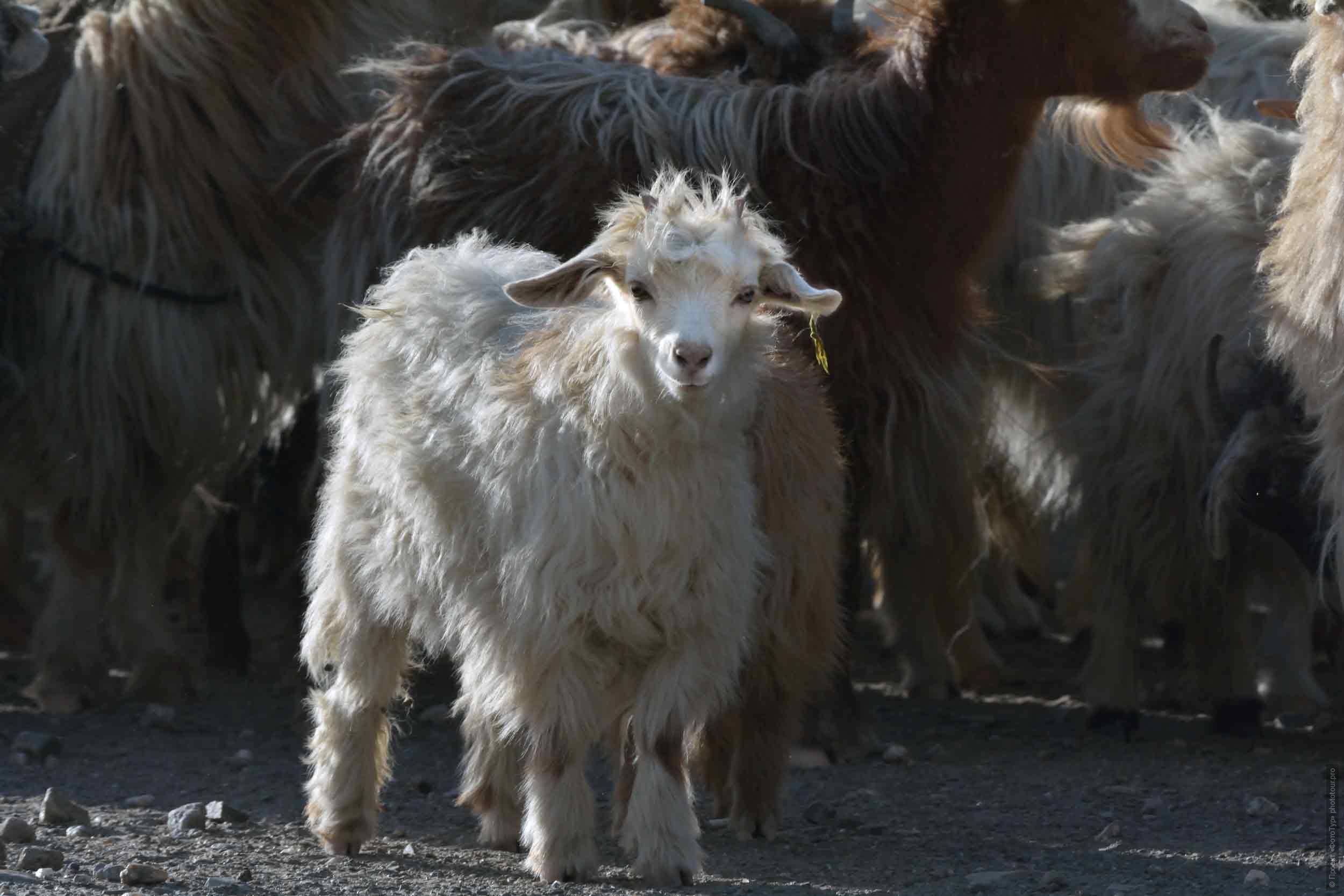
By the way, the farm is located in a very beautiful place - directly opposite the entrance to the Burgundy Gorge, this is the place where huge layers of rocks literally reared and lifted themselves towards the sky.

We will spend the whole day in the fresh air - here the first yellow trees of the Ladakh autumn are shining with bright lanterns among burgundy rocks:

And the walls of the gorge are more like abstract paintings:
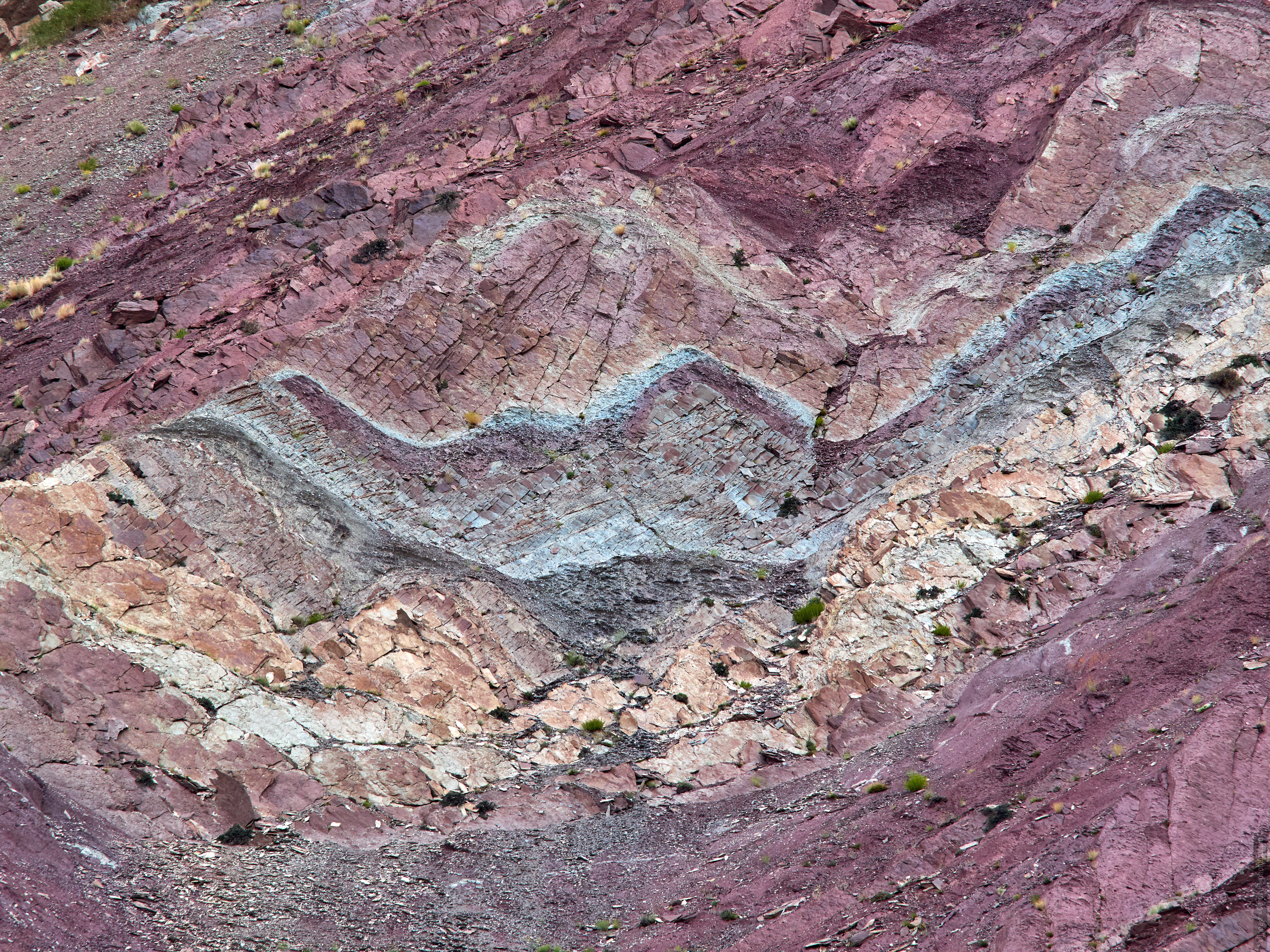
In the evening, with booty and a lot of impressions, we return to Lech.
Hotel in Leh.
Day 4, September 3: Lech. Tibetan Medicine Clinic Men Dze Khang. Workshops of the Mothers Center of Ladakh. We are located within Lech, height is 3,600 m.
Two big events and one small await us today, today we will visit:
1. Institute of Tibetan Astrology and Medicine Men-Dzi-Khang in Leh.
And do you know what the Men Dze Khang clinic of Tibetan astrology and medicine is?
Tibetan medicine, as a medical system, was born in its historic homeland after the adoption of Buddhism.
Tibet began to use the knowledge of Gautama Buddha, who devoted many of his writings to this topic.
Also, certain concepts were transferred to Tibetan medicine from the ancient Bon religion.
Many great rulers and lamas of Tibet devoted themselves to the study of the knowledge of Tibetan Medicine, institutes and clinics were built.
At the beginning of the 20th century, this knowledge and skills were systematized and the Men Tse Khang Institute of Medicine and Astrology was founded.
He is under the strict guidance of His Holiness the Dalai Lama XIV.
His Holiness transferred the Institute from Tibet to India after the invasion of the Chinese and is now controlling its activities from its winter residence in Dharamsala.
In Leh, the Tibetan clinic Men Tse Khang is accepted by doctors who have gone through school at the Men Tse Khang Institute.
There will be an opportunity to undergo pulse diagnostics from Tibetan doctors, if desired, to purchase Tibetan natural products, the action of which is aimed primarily at eliminating the cause of the energy imbalance in the body.
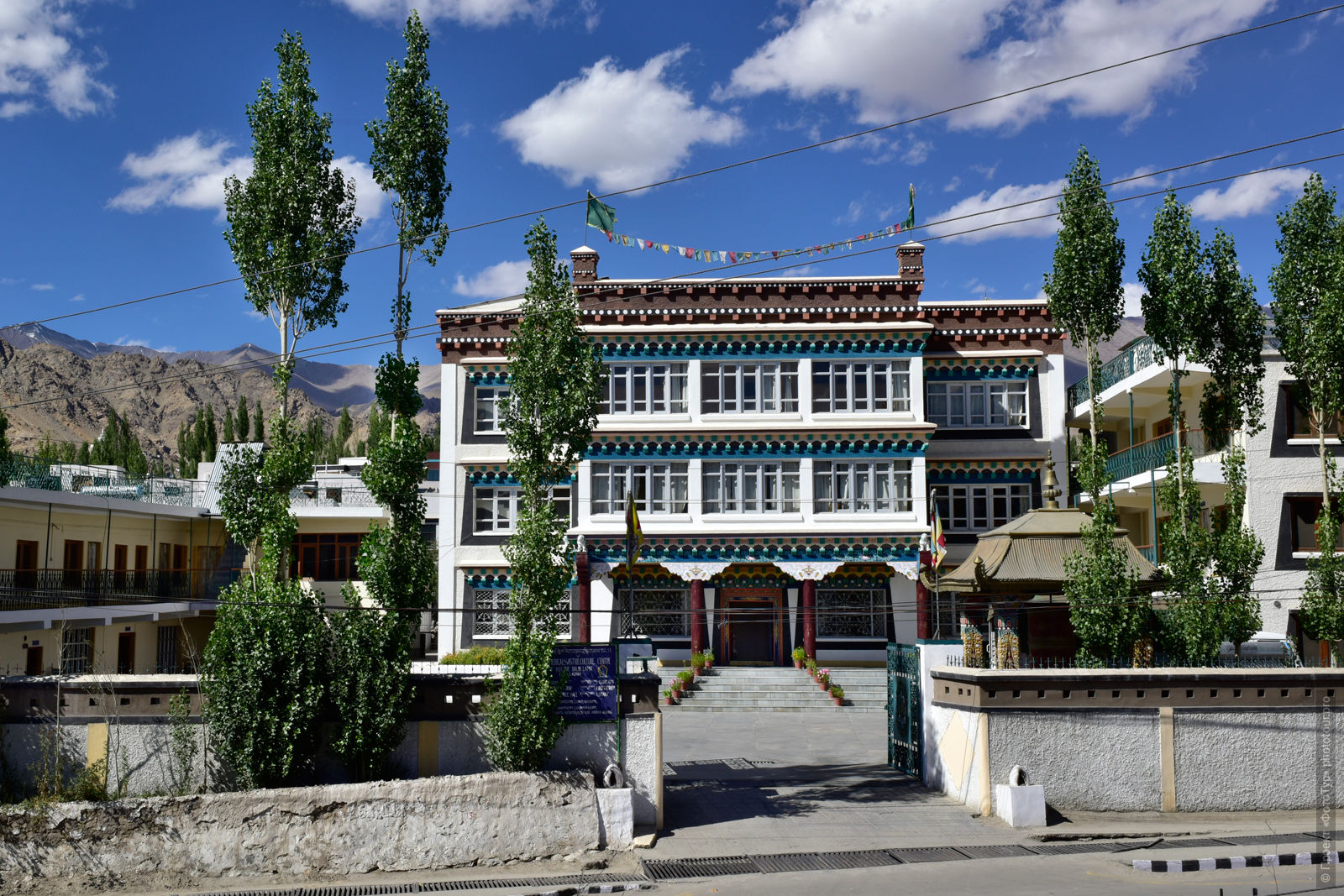
We will also visit the Institute’s museum, it is very interesting here - ancient manuscripts, medical instruments, medical thangas and much more.
We will see ancient manuscripts, we will wander through the quiet rooms of the museum:

After that we will visit the shop at the Men Dze Khang clinic and we will be able to buy wonderful herbal shampoos for which the hair simply comes to life, Tibetan face and hand creams, teas, incense and even amulets that Tibetan lamas make.
And with all these riches we go further).
By the way, if there is a desire to learn more about our Men Dze Khang Clinic in Ladakh, then we have a whole topic on our website dedicated to this clinic - in 2016 we shot a film on the Men Dze Khang seminar and these materials are posted here:
Tibetan Medicine Seminar, Men-Tsi-Khang, Leh, Ladakh, August 2016.
2. In the afternoon we will first go to the workshops and shop of the Mothers of Ladakh.
Let this part remain a surprise, let me just say that we will get acquainted with the creative works of Ladakh girls and will observe the work itself.
3. And we will spend the evening in the small antique shops of Leh.
Here we must immediately make a reservation that Lech is, in general, a completely non-commercial zone and most store owners stand behind the counters and, in essence, they are not so much sellers as collectors.
And this means that our evening is waiting for an evening of very interesting stories - owners of antique shops are happy and many (in English) talk about what interests you, an evening of scrutiny - we will see ancient Ladakh clothes and jewelry, which means an evening of creative ideas.
Get saturated!)
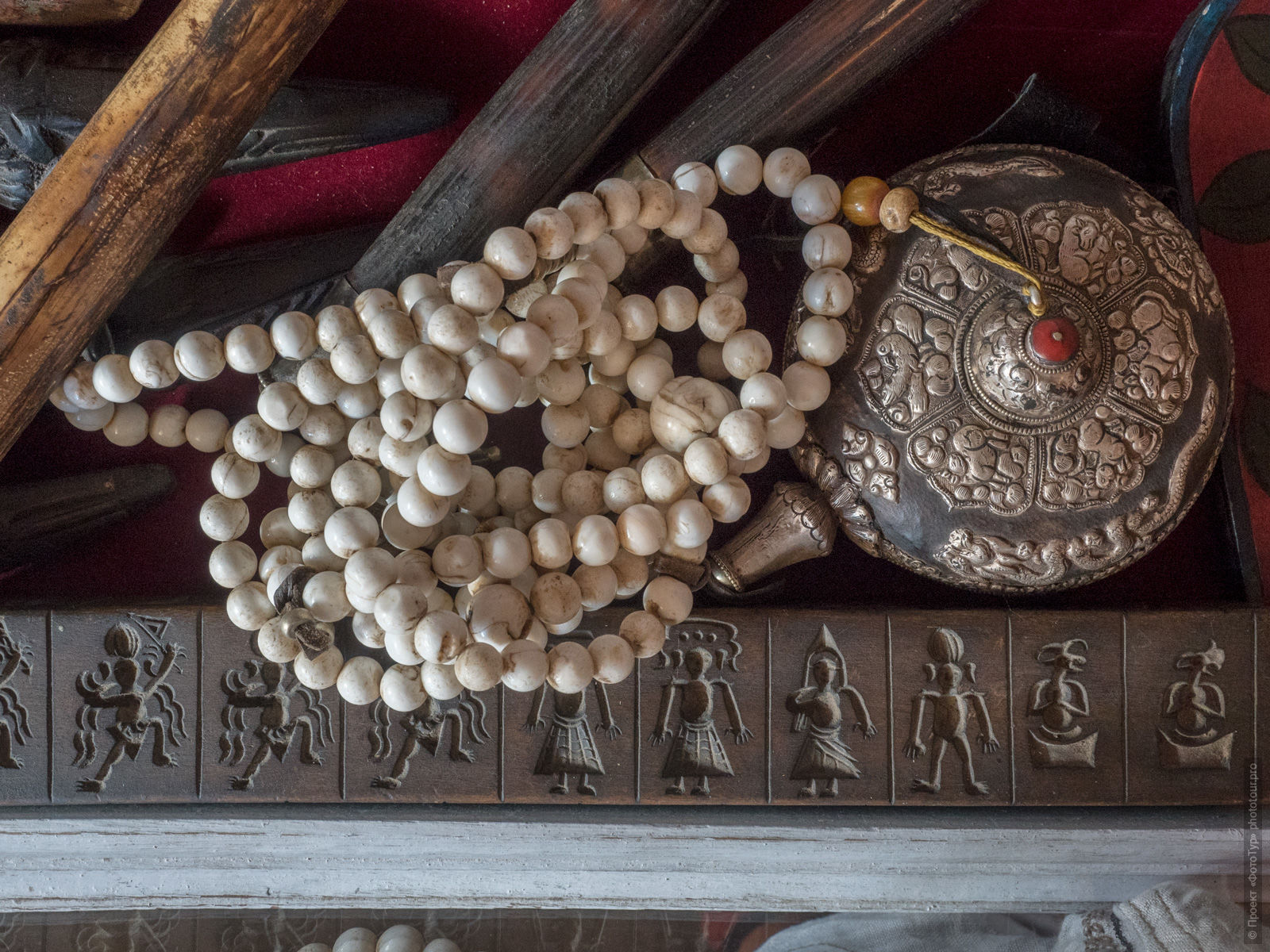
In the evening, tired, happy, shopping and having a tasty meal, we return to our cozy hotel.
Hotel in Leh.
Day 5, September 4: Leh - Basgo Monastery - Likir Monastery - Hemis Shukpachan village. Acquaintance with the life and everyday life of a Ladakhi woman, about 100 km, altitude 3,600 - 3,200 m.
And today, from our nest hotel in Leh, we go on a multi-day walk through the valleys of Ladakh, downstream the Indus River, we will lose altitude every day, and we will get warmer places.
The morning will begin with a very beautiful car ride downstream of the Hindu, here's the unearthly landscapes, we guarantee you exactly).
First - the Buddhist Monastery Spituk Gompa, not far from Leh - the monastery over which we flew when we sat at Leh airport.
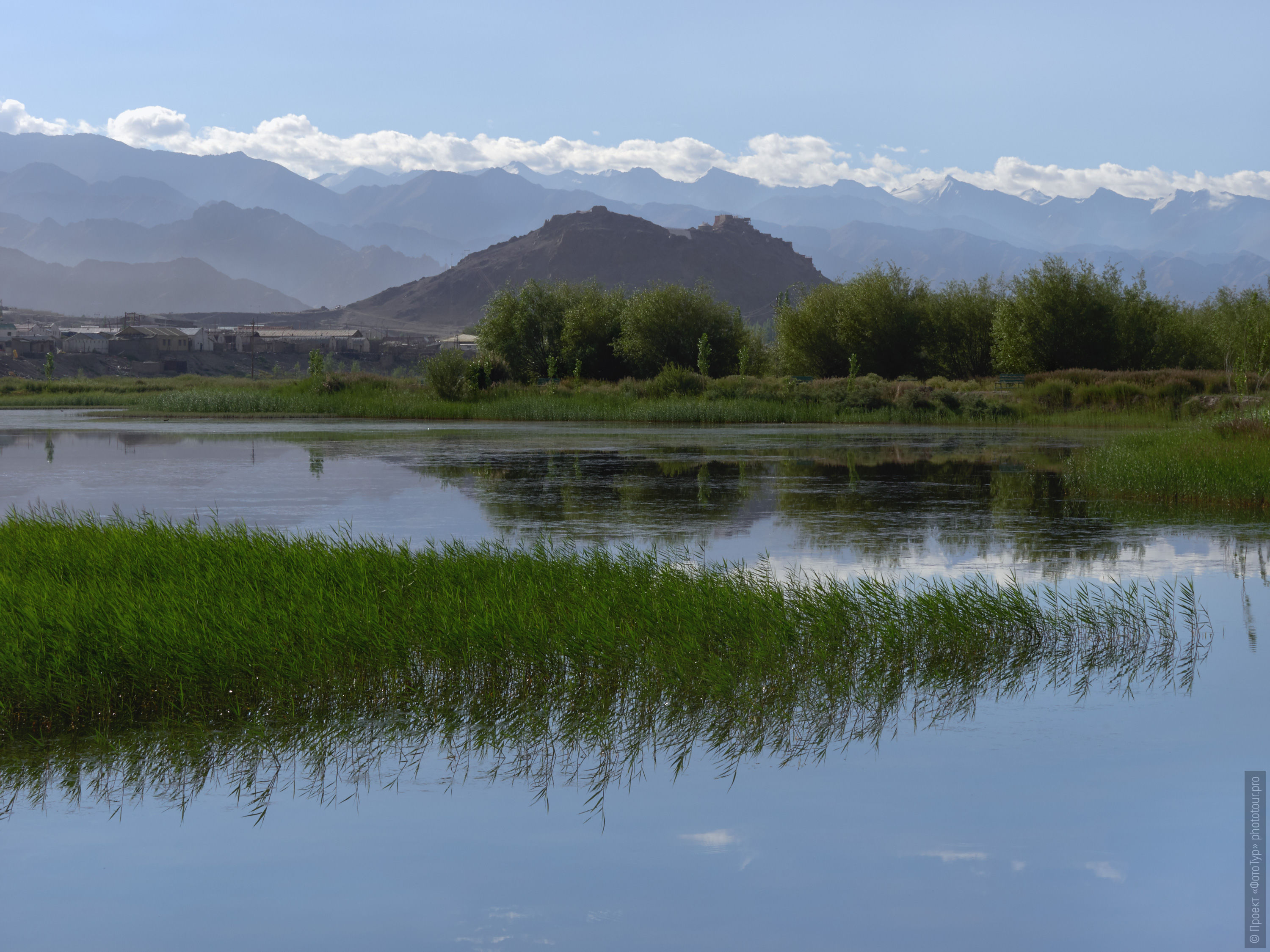
Then - the confluence of the Indus and Zanskar rivers:
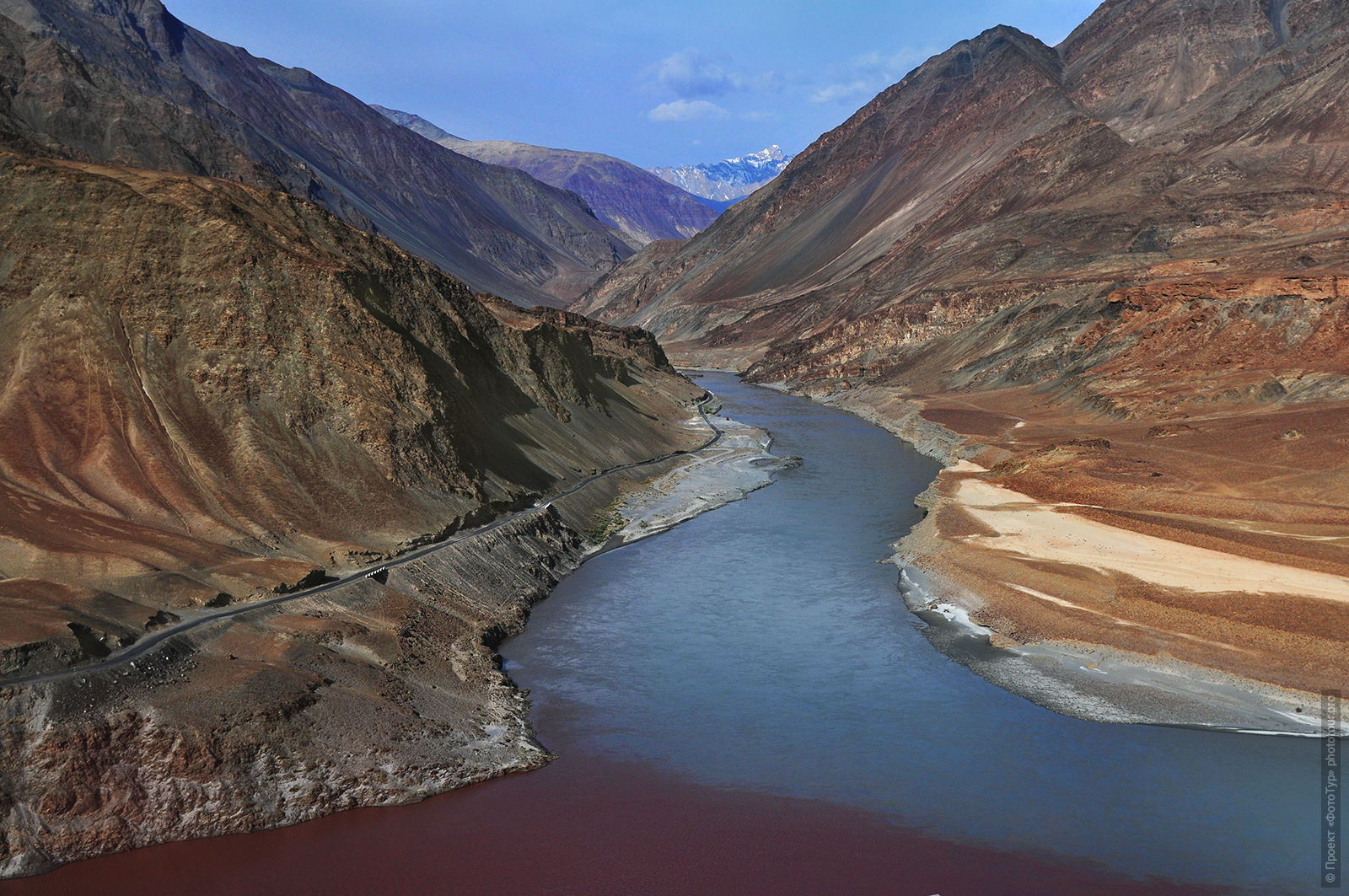
And then we will visit the incredibly beautiful, hovering in maroon cliffs, as in the air - the white Buddhist monastery of Basgo Gonpa.

We will stop at the entrance to the monastery of Basgo and walk along the mountain road to the ancient buildings of the Gonpa.

And then we will walk in the monastery's natural park and go inside the gonp to see ancient sculptures and paintings that are more than 500 years old:
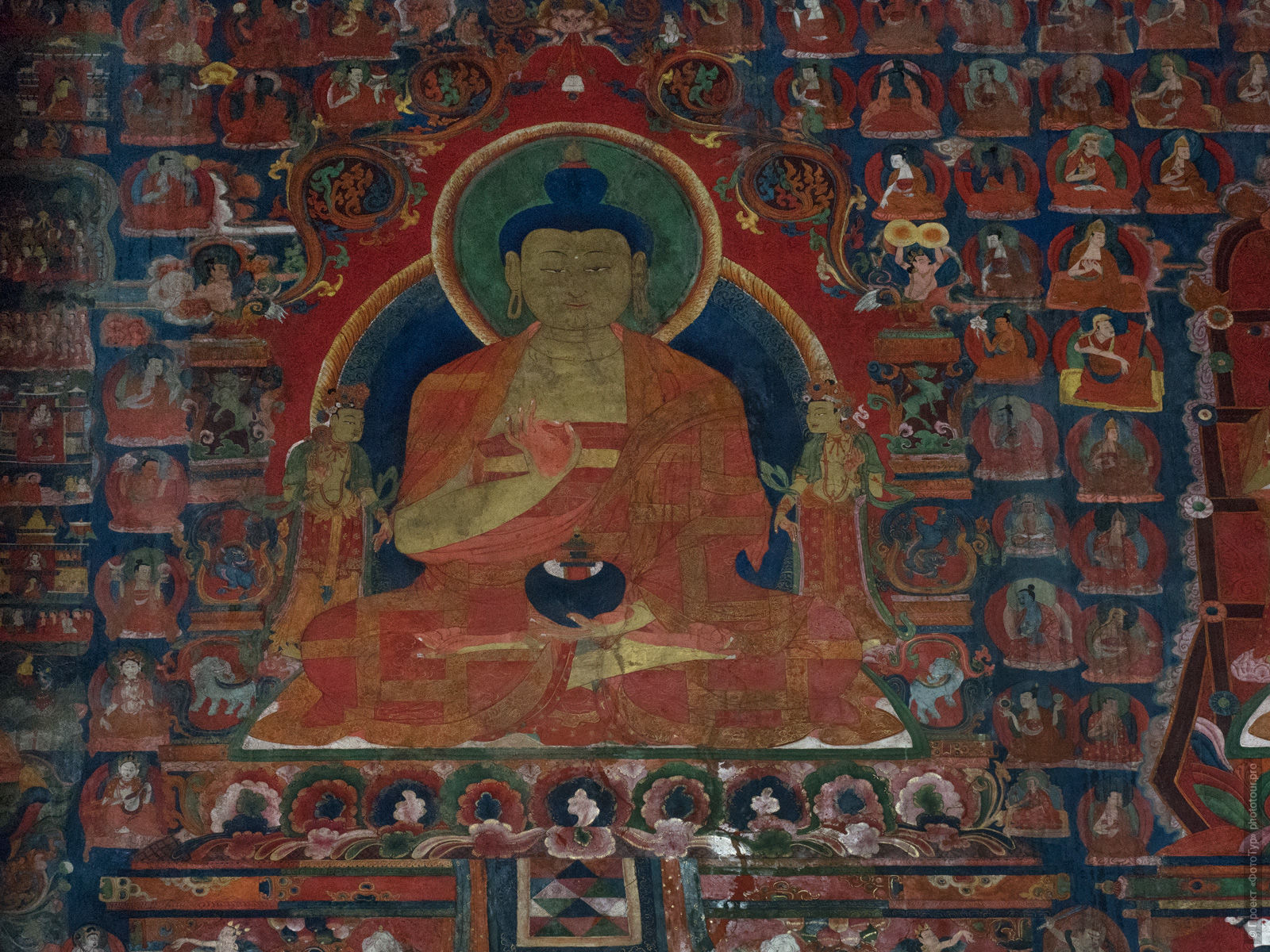
The monastery complex itself is incredible, Basgo is probably the most unusual monastery in Ladakh and that is why Bollywood romantic films are often shot here:
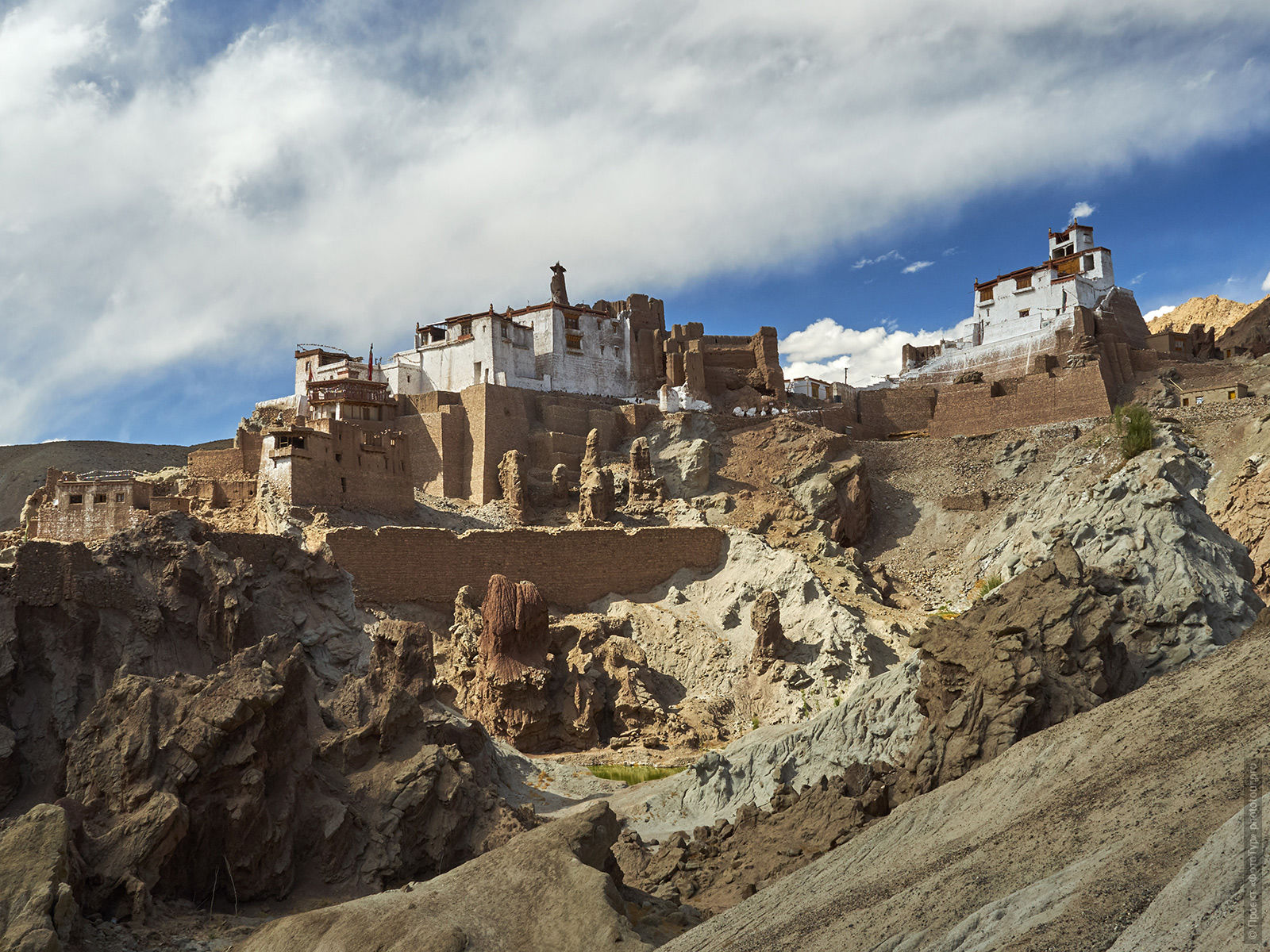
After the Basgo Monastery, we will have lunch at a small roadside local tavern in Nyimo:
Here they cook the most delicious tsampa air cakes and the coolest samosas - every passing local will definitely stop here to take a little bit of delicious food with them on the road.
And further on the road - we still have to visit the Buddhist monastery Likir Gonpa.
This is a very unusual monastery and in a very beautiful place.
By the way, the abbot of the monastery is the younger brother of His Holiness the Dalai Lama XIV.
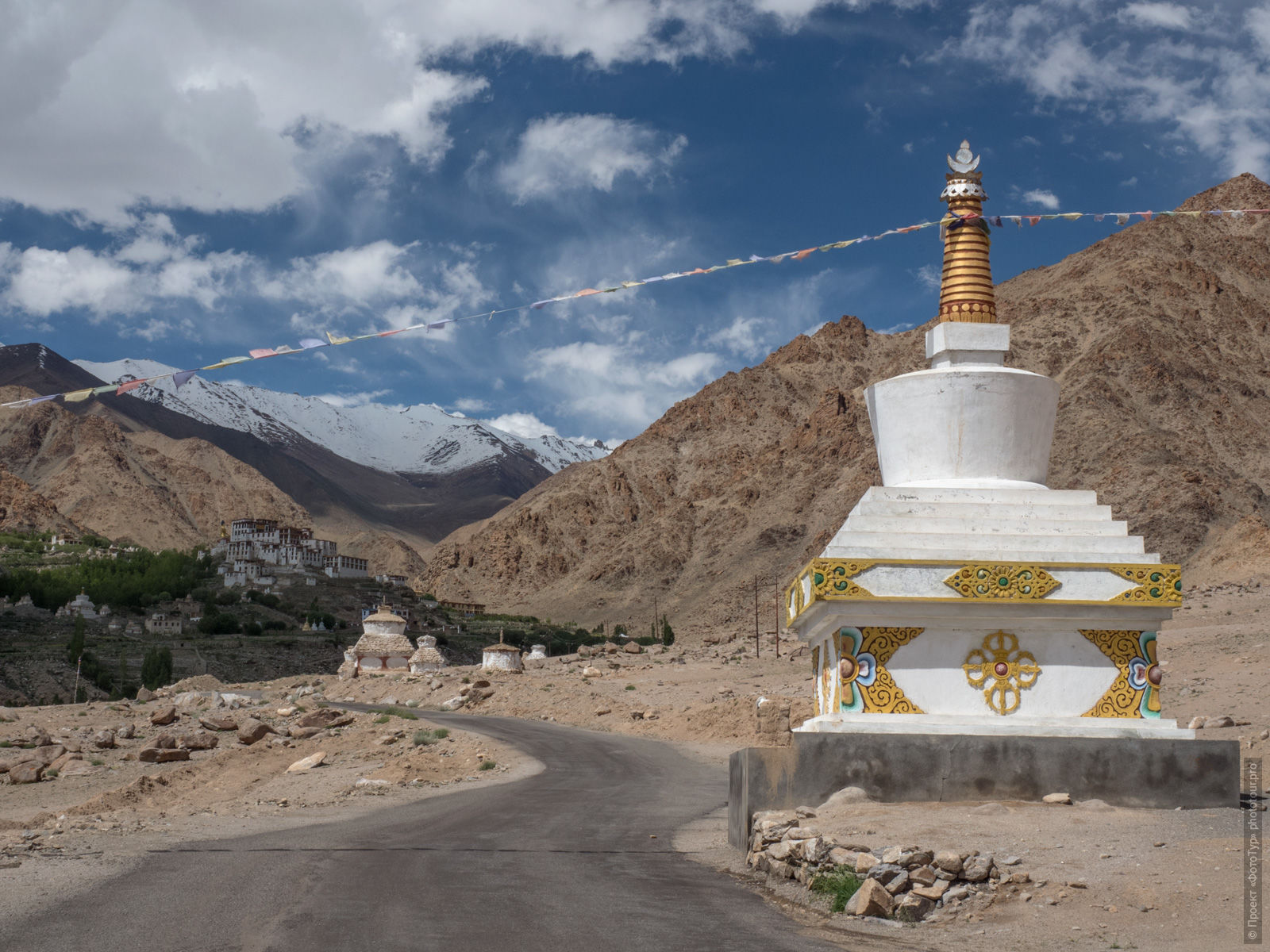
In front of the monastery there is a huge gilded figure of Buddha Matreya:

And then, after Likir, we follow the mountain road to our native village of Kakar Lompo - Hemis Shukpachan village.
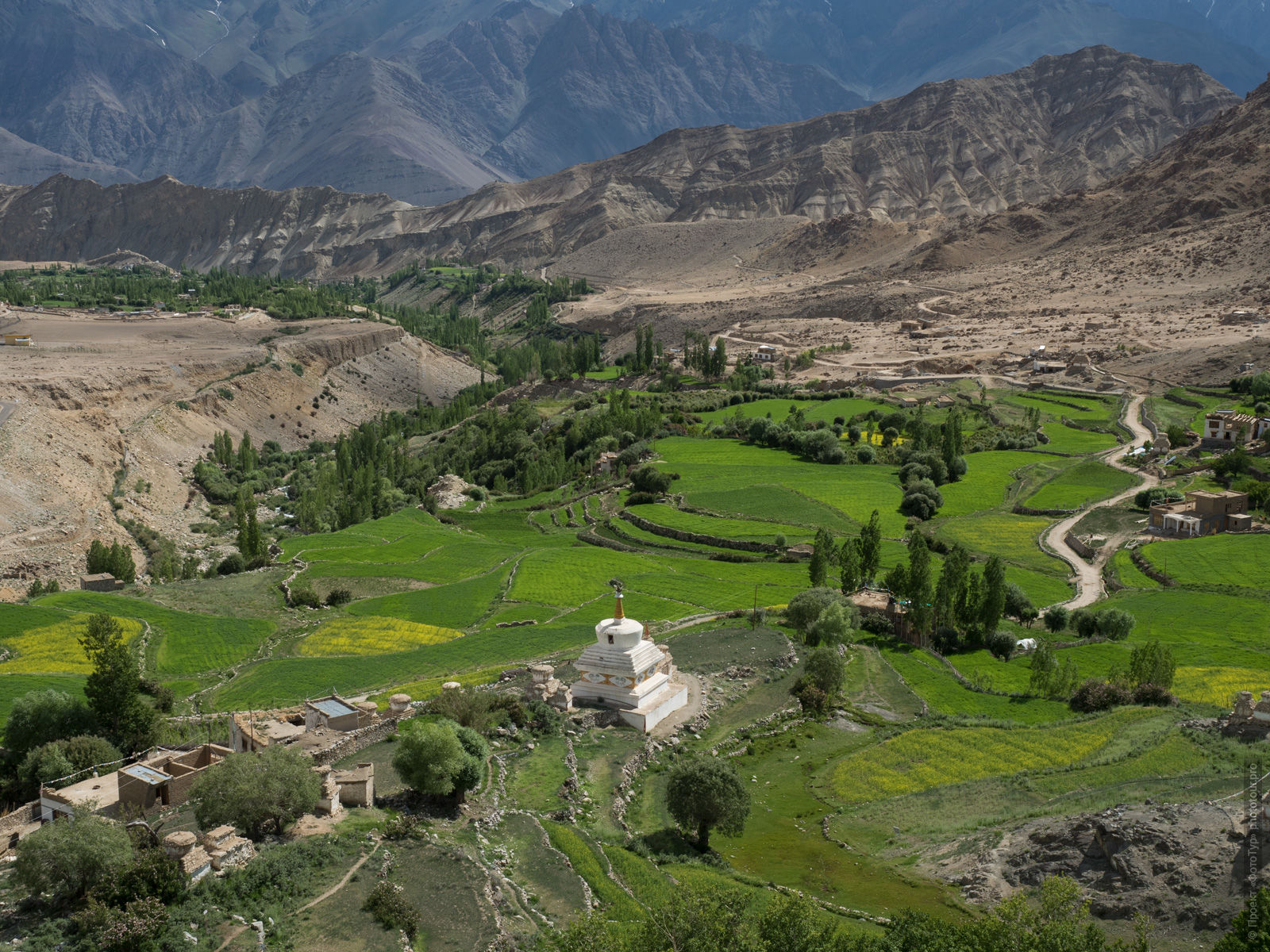
In the evening - Kakar Lompo lectures on the place of women in Tibetan culture, studying the life of Ladakh women.
Guest House in the village of Hemis Shukpachan.
Day 6, September 5: Hemis Shukpachan - Domkar, Da Hanu Gorge. Picnic with Aryan women. Evening walk through the village, 120 km, altitude 3,200 - 2,800 m.
Today we are going to a very unusual part of Ladakh - to the Aryans, in the valley of Da Khan.
Da Khan gorge was opened for tourists recently, in 2010, and some villages, much later, for example, Khan Ekma, were opened for tourists only in 2013.
Nevertheless, these are those Tibetan lands, about which many rumors and legends circulate.
It was in these villages that Hitler organized expeditions "for Aryan blood."
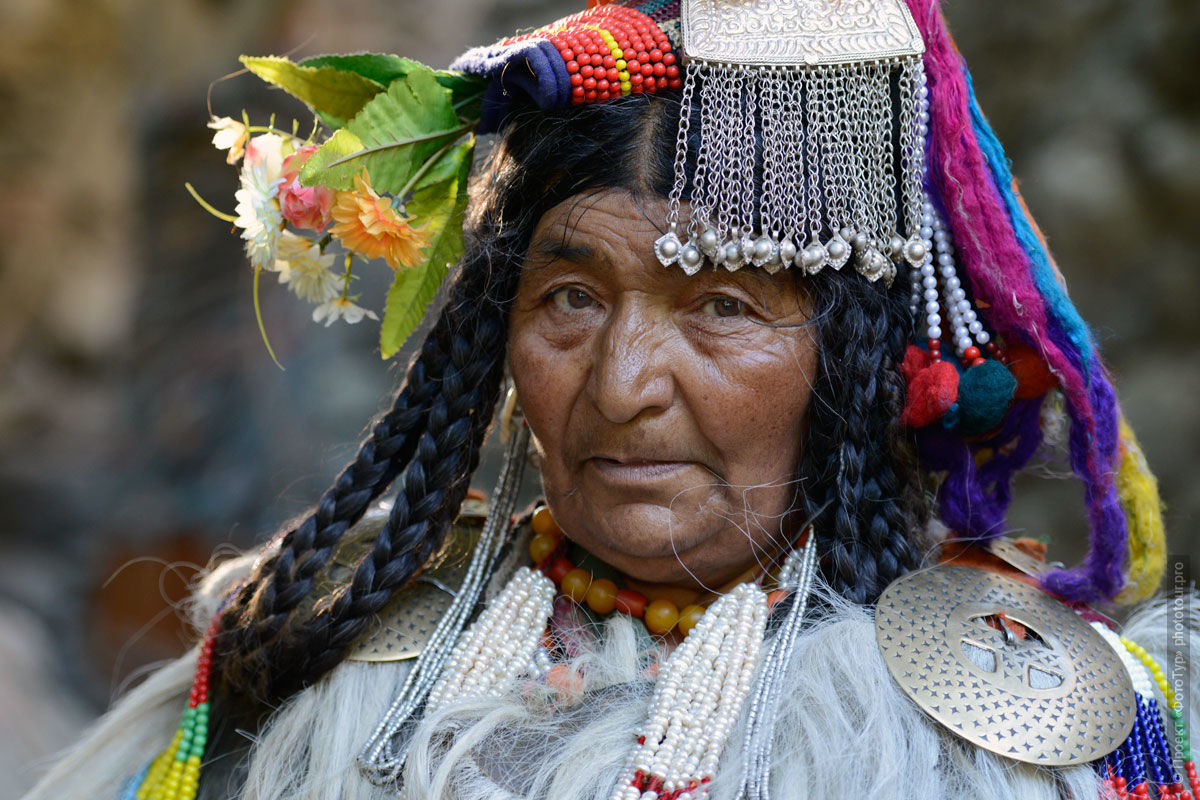
Currently, there are two Dard tribes on the territory of the former Ladakh kingdom, which have preserved their native language: Dhards from Dra, and Dards from Da (Dha).
The first became Muslims in the 16th century.
The most interesting case is the dards from Da (Dha - Hanu).
They did not accept the faith of Mohammed, but Buddhism was not fully accepted by them - their religious practices more resemble the ancient pre-Buddhist religion of Bon.
Thanks to this, they were able to preserve their cultural uniqueness.
Their external dissimilarity and peculiarity lies not only in the shape and features of their faces, but also in the details of their ethnic clothing.
All men and women wear a headdress, the main decoration of which are the red flowers of Physalis (wild strawberry), which protect against demons and bring wealth.
In all forms of art, the Drokpa has symbols of the swastika and the sun: in carved ornaments on houses, in ornaments of antique dishes and household utensils.
There are also many natural and astronomical symbols.
Drokpa surprisingly combine mixed traditions in relation to food - they do not eat poultry meat and cows, but keep them for eggs and milk. Eat only lamb.
There are around 2,000 Aryans left in Ladakh and they live in 5 villages and only marry within their own ethnic group.
There are very few tourists in this area, also because tourism infrastructure is practically undeveloped here.
But we are going here to our friends - Sonam, partner and co-founder of our travel company was born and raised in the Aryan village of Domkar.
This part of the tour is completely exclusive, no one else does anything of the kind, and the gorge of Da Khan is amazingly beautiful:
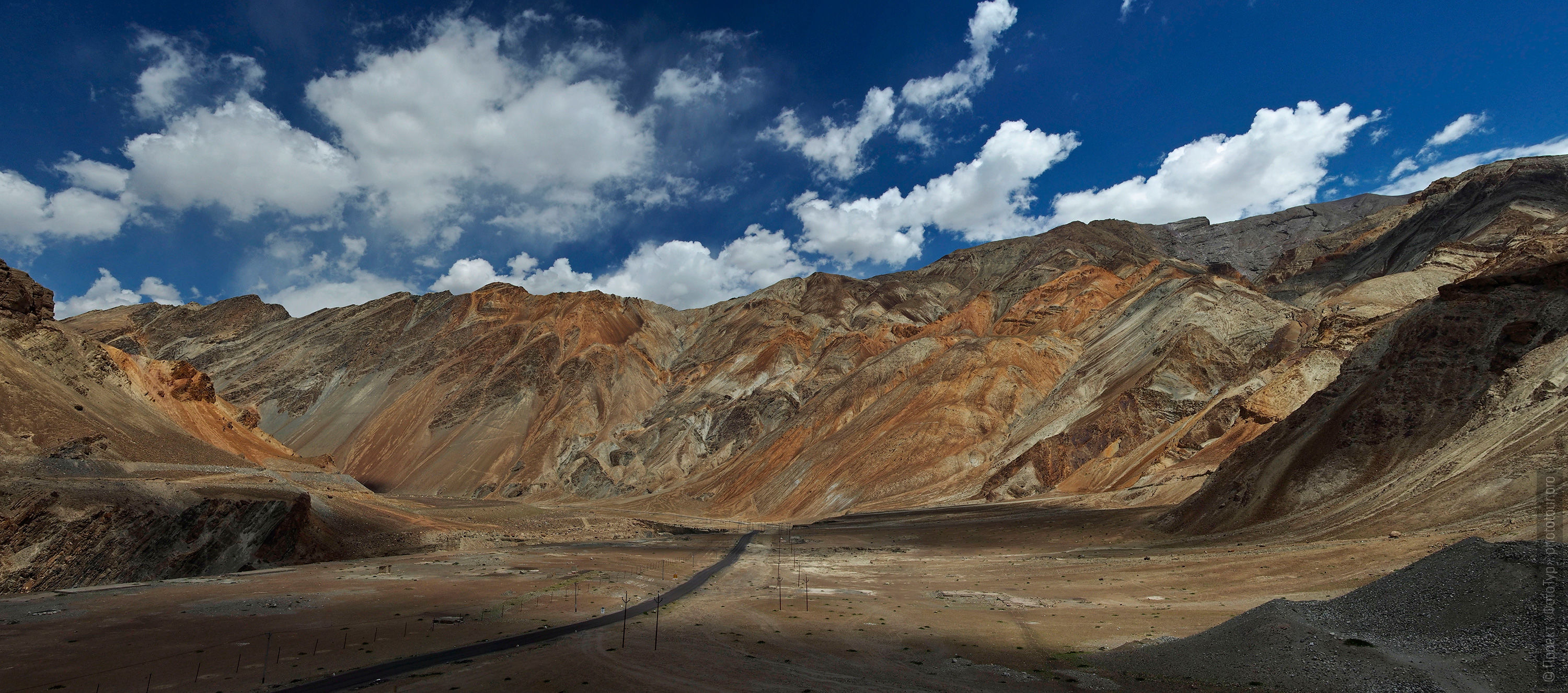
It is incredible, fantastically beautiful, unreal, the laws of gravity do not work here - the first thing that comes to mind when you see white stupas hovering among colored, striped mountains:
With a little irony:
the place is so authentic and truly present that there are no tourists here - and there is no place to even have a bite, there is no tourist service.
We are going to visit, to real friends of Ladakhs - to our friends, in the past - in 2018 - Sonam built the hotel here, the only one in the whole valley).
And not just a hotel, but a hotel with magnificent thick mattresses, spacious rooms and round-the-clock hot water.
And all this in a small mountain gorge from all sides closed from the winds) in an environmentally very clean place.
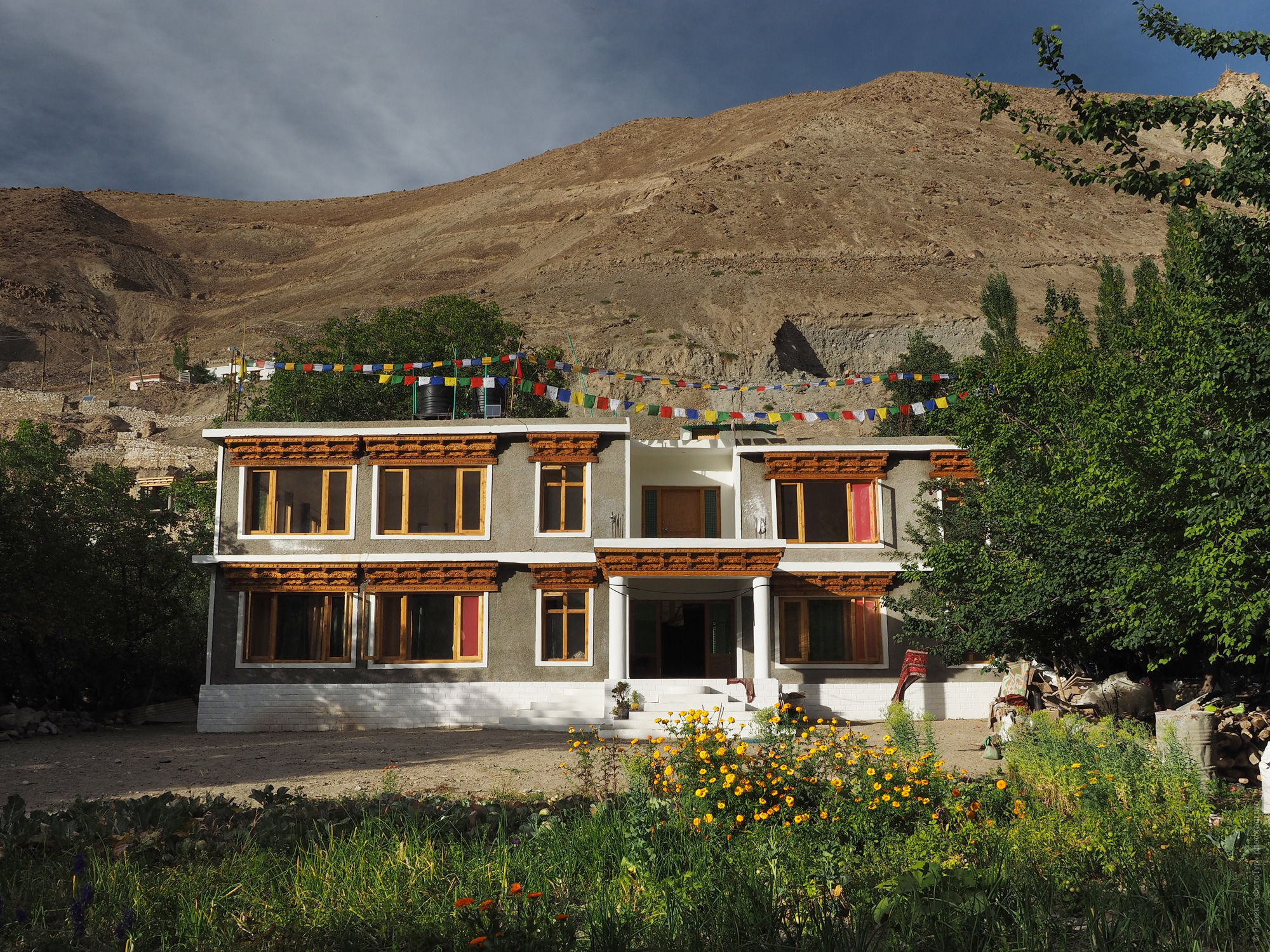
By the way, in the village of Sonama in the river there is very tasty water - it is very tasty to drink it, gathering with handfuls - straight from the river.
Purest - flows from high glacial peaks:
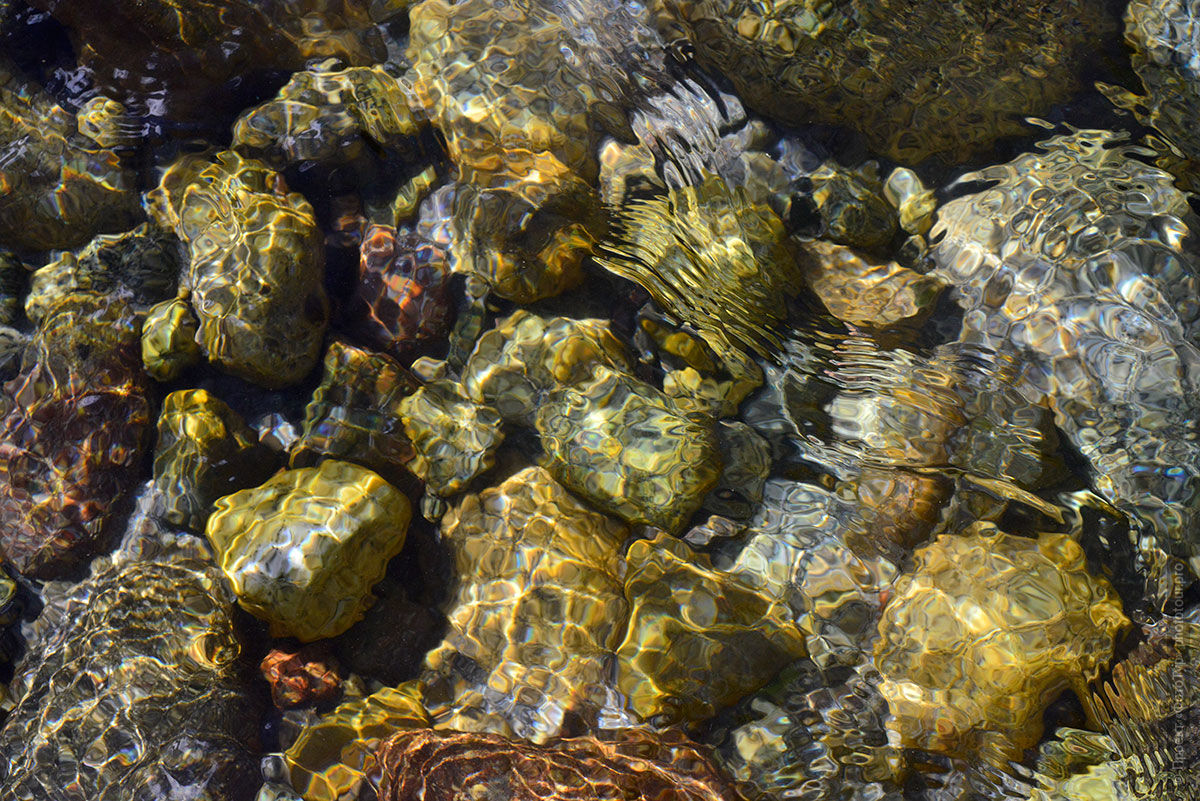
And in the evening - Picnic on the river bank in tents with local ladies.
It will be delicious, fun and interesting.
Here - how it will go, but usually it goes very dynamically, and without testing song dancing, testing never failed.
Let this part be some surprise.
Hotel in the village of Domkar.
Days 7-9, September 6 - 8: Workshop of Marina Klimchuk on felting and working with Ladakh wool, height 2,800 - 2,600 m.
In the next three days in the first half - seminars of Marina Klimchuk.

ATTENTION!
It will be necessary to prepare for the course in advance, to create your own creative image and then, at the place of the tour, supplement it with details, local flavor in Ladakh.
Bring your stylish Tibetan outfit to the perfect lines, inspired by staying in the perfect world of beauty and harmony.
In the days of practical felting, we will test the wool of local animals: sheep, yaks, goats, camels.
We will get acquainted with the traditional centuries-old experience of felting craft in Tibet and can be applied in the future in our art projects.
The highlight of the felting course in Tibet will be a professional photo shoot, a defile of wonderful costumes.
Images that will be filled with special spirituality.
Things are the forces that will bring life in the future: luck, confidence, harmony and saturate the everyday routine with colors.
ATTENTION!
One of the days of felting will be devoted to the manufacture of hats that will complement the costumes of Ladakhi Defile.
What is necessary for this to prepare and bring with you to Ladakh:
Merino 18-21 micron wool - 50-80 g (one or several harmonizing colors) - depending on the chosen model,
The work will also use fleeces of local animals: yak, sheep, camel.
And we will sculpt hats absolutely incredible - in the style of authentic Ladakhi festive decorations).
In the second half of each of these three days, we will take part in the following events:
1. Practical workshop on cooking Tibetan cuisine.
Kakar Lompo will talk about the basic principles of Tibetan cuisine and together we will prepare a large number of dishes for our next evening picnic.
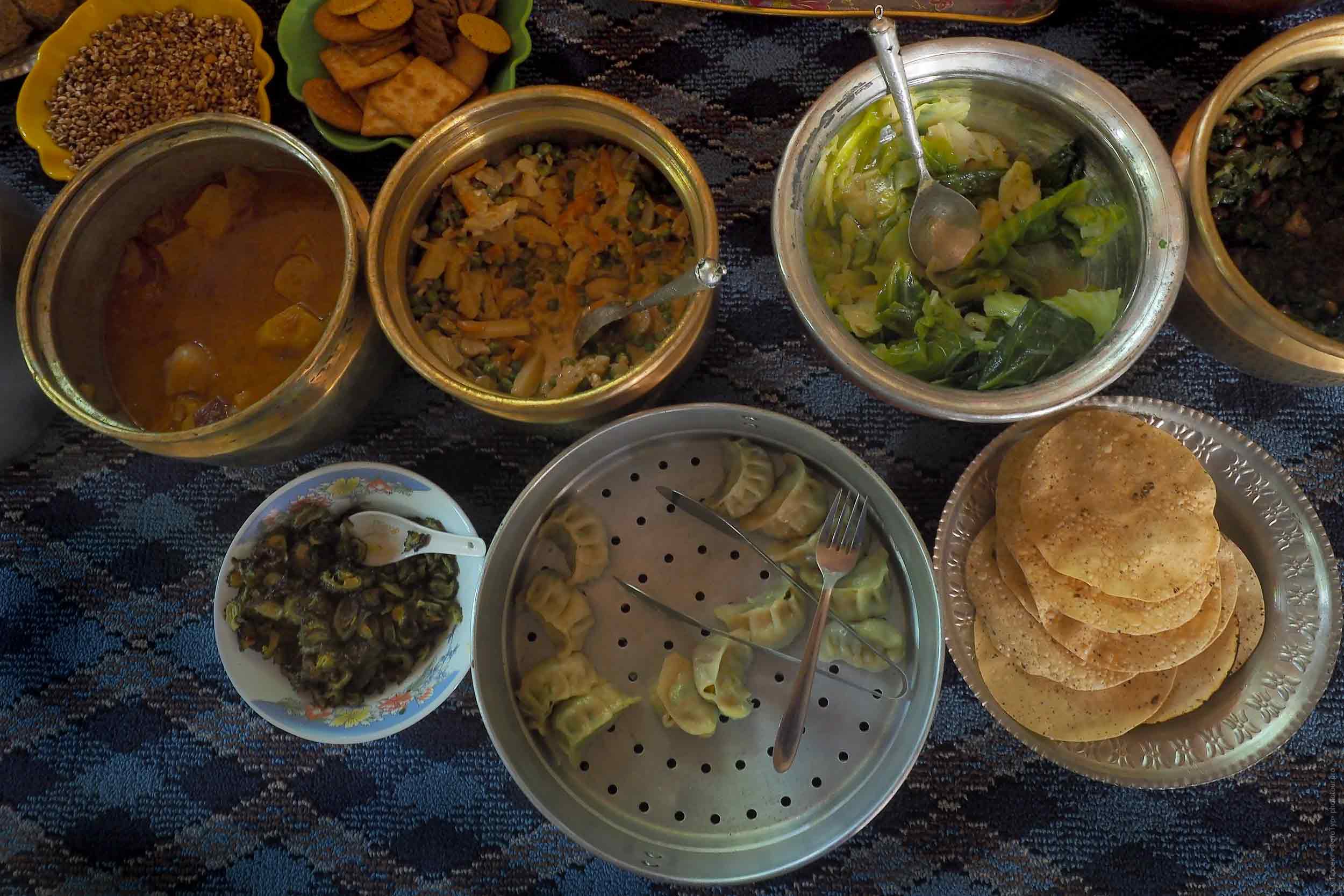
2. Master class on Tibetan women's clothing and jewelry.
Again, solid practice:
Kakar will tell about Tibetan clothes - how, what, why, about the symbolism and everyday meaning of Tibetan jewelry.
And then we move on to the practical part:
Each of the participants will have the opportunity, under the guidance of the young ladies of the village, to wear the full national costume of a Tibetan woman.
And here, too, a pleasant surprise - now from Ilona Kryzhanovskaya:
Each participant of the tour will receive a portrait in national dress in the interior of a Tibetan home.
3. Practical exercise with Ilona Kryzhanovskaya on cleansing energy practices.
4. Walking around the village of Doncar:
the village is very old, more than 400 years old and preserved in its original form, new buildings here fit into the empty seats.
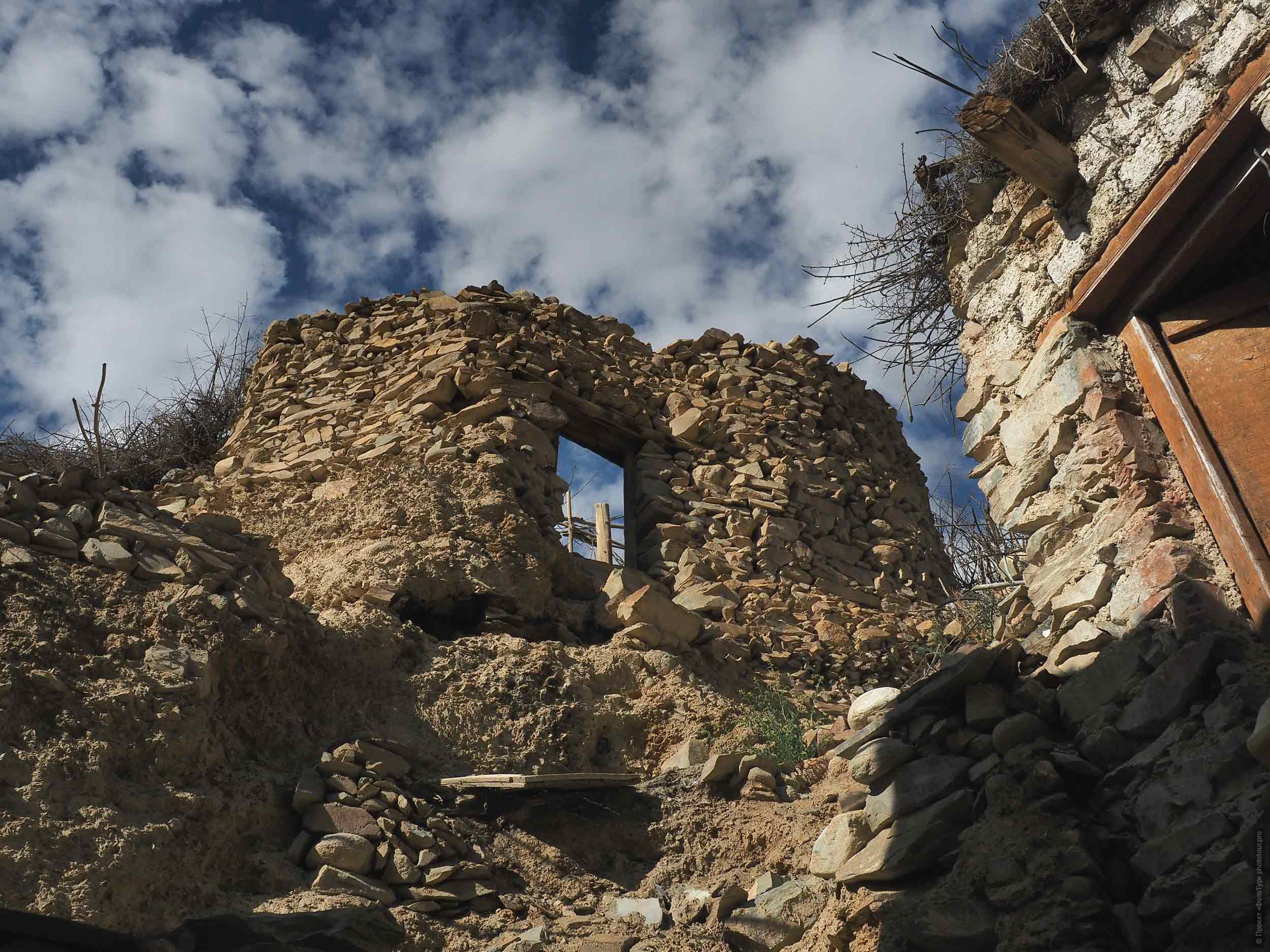
Old houses, abandoned, do not break or rebuild.
Moreover, inside the old houses everything was preserved as during the life of the owners - and even the ancient pagan altars.
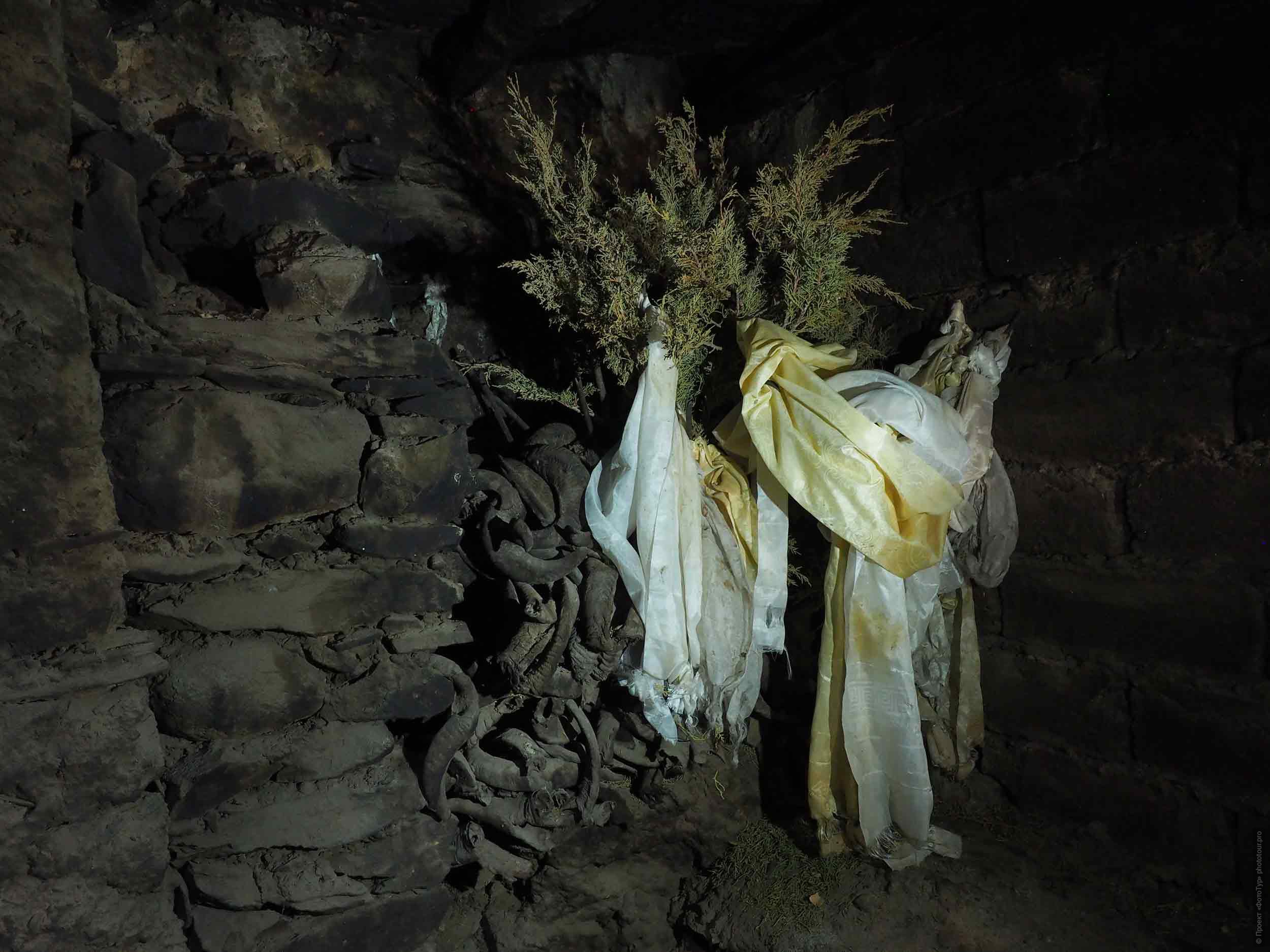
The interiors of such houses are amazing.
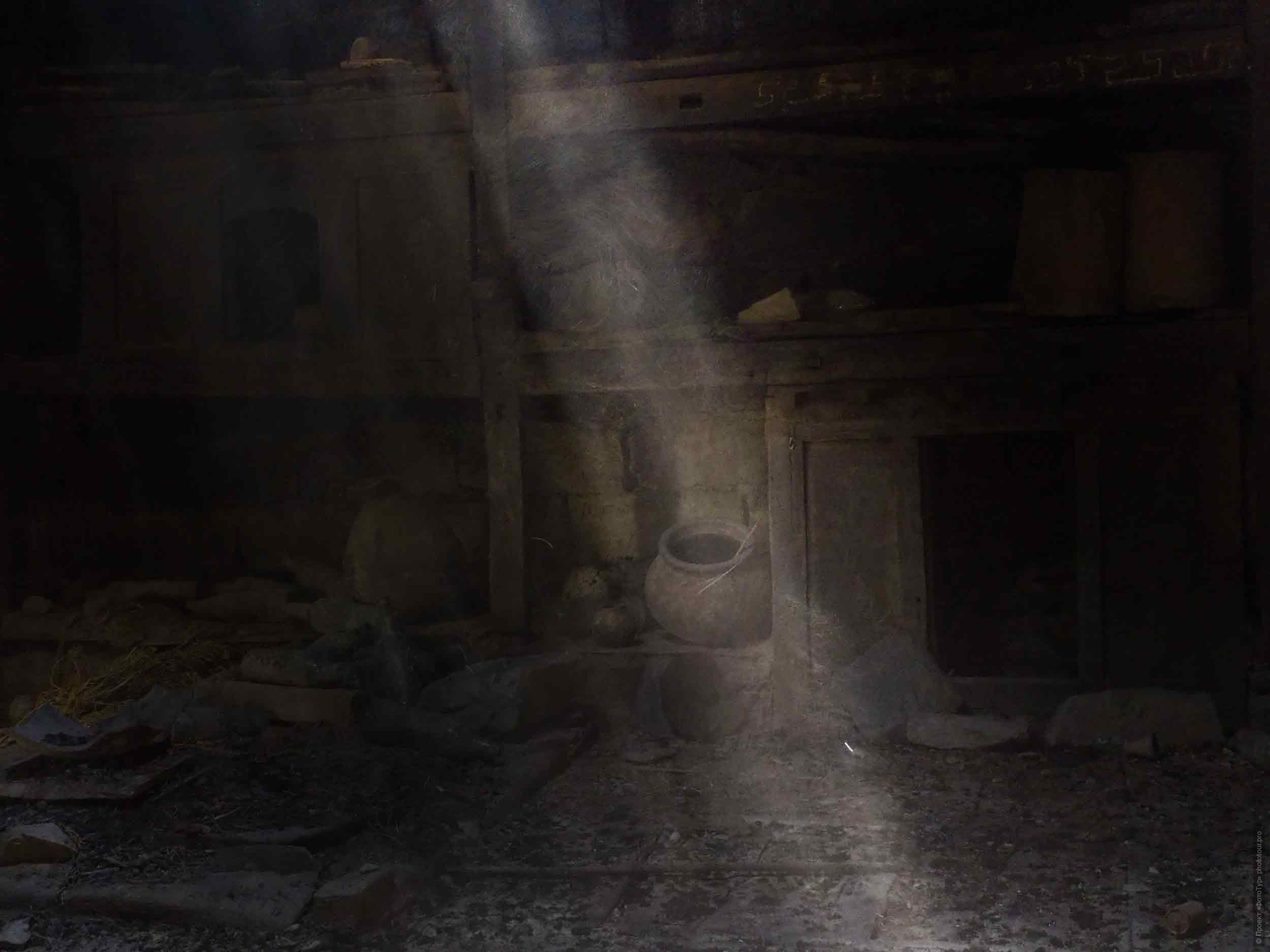
Visit a local small village gonpa, puja for our group.
For some time, we will disperse - someone much more like it, the village is small.
The doors of all houses will be open for us, it will be possible to enter almost any house, we will be happy - local ladies love guests.
5. And, of course, we will ride in our free time along the valley of Da Han, see old stone villages that are 600 years away - pay attention - how the houses fit into the mountainside.
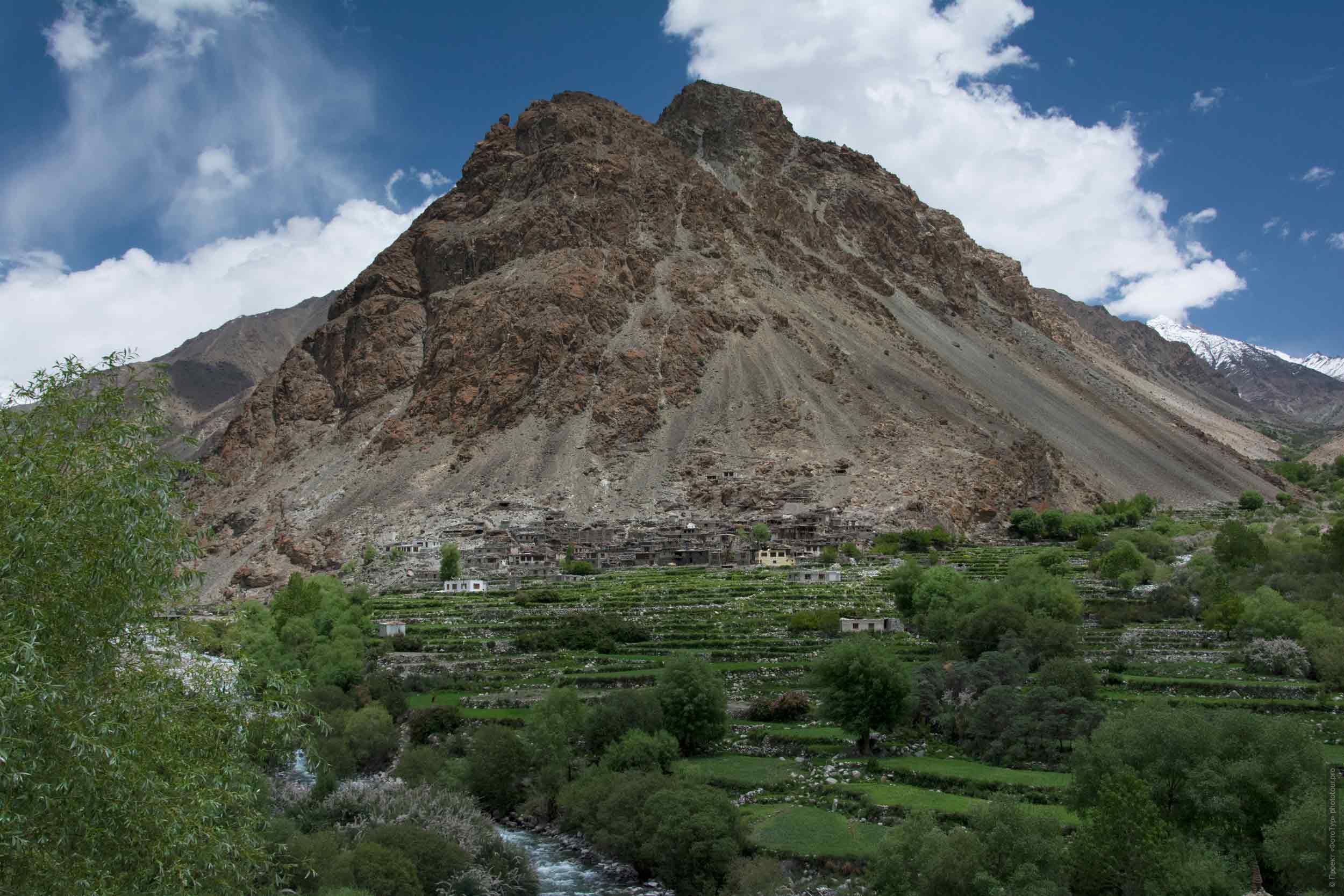
This is a very old village and it is in close proximity to the Pakistani border. The village is unique:
all houses are made of river pebbles, without a single gram of cement, clay, nails, etc.
Pebble boulders did not grind, but just fit very accurately into the walls - this is an incredible piece of jewelry.
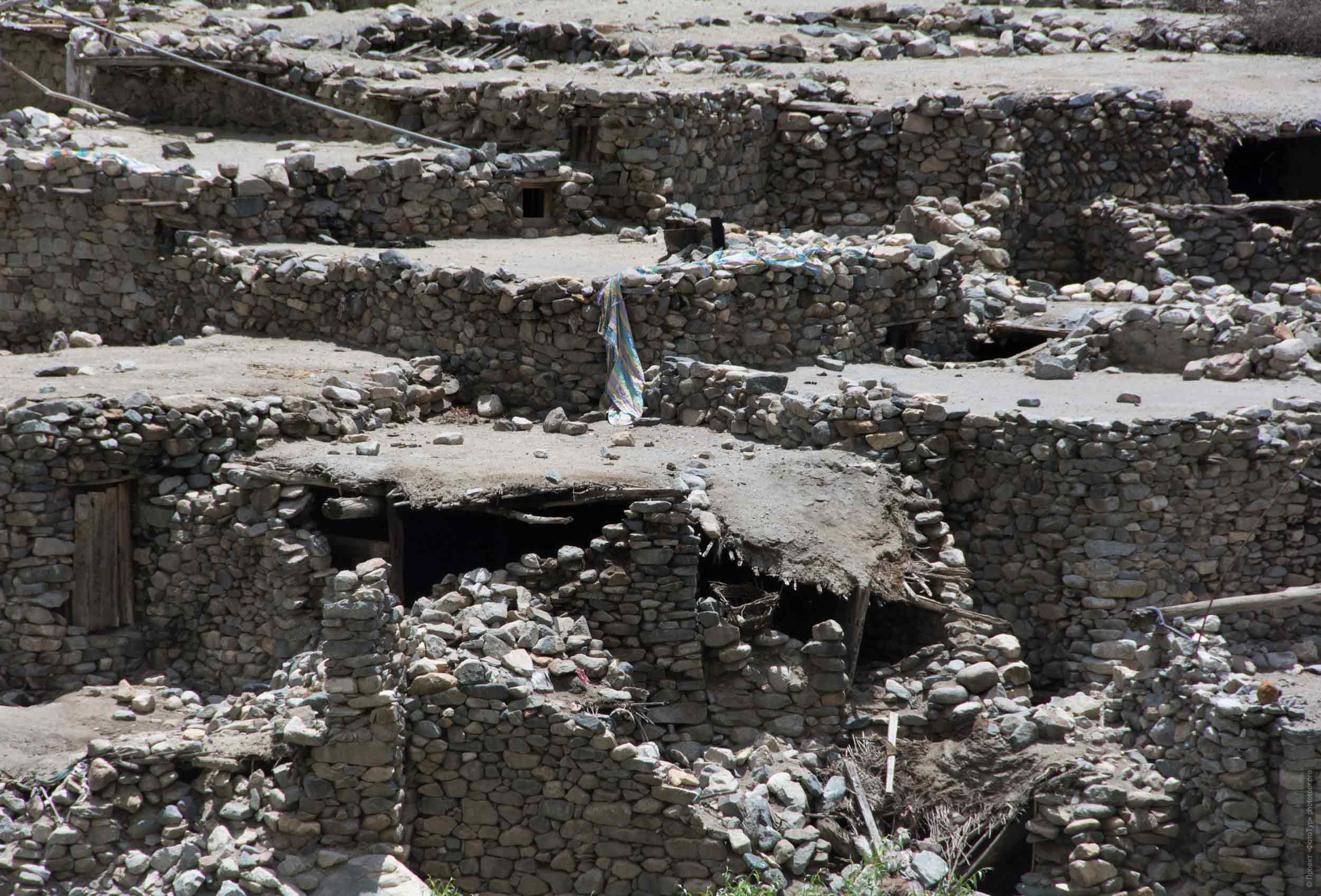
We will visit local schools, gonps, see how Aryan villages live, and, of course, talk to local beauties.
.jpg)
And around us there will be silence and small Buddhist monasteries of the Aryan valley Da Hanu.
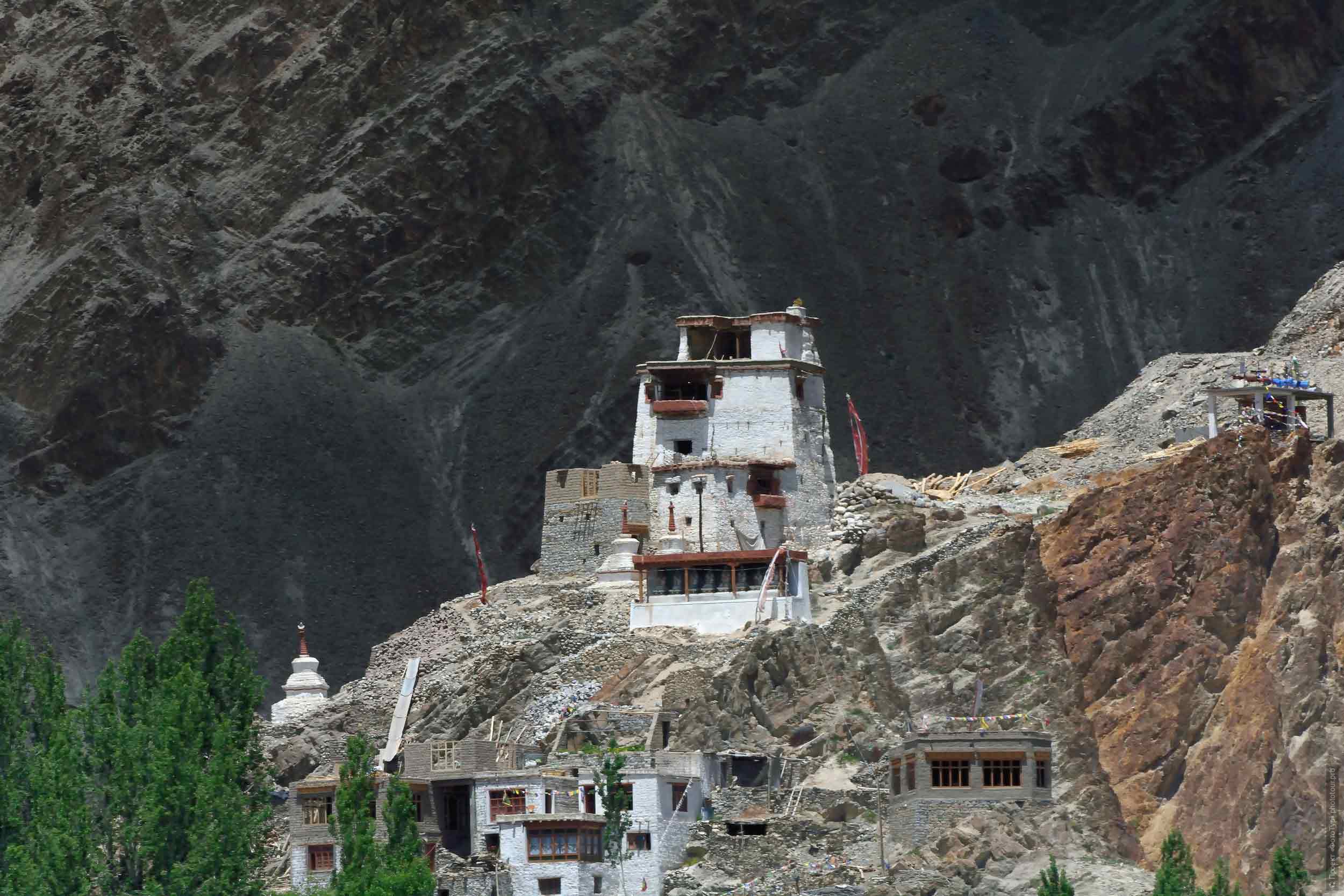
Hotel in the village of Donkar.
Day 10, September 9: Moon Land, Lamayuru, photographing the costumes of Ladakhi Defile. Return to Leh, about 140 km, altitude 2,800 - 3,600 m.
All good things always end, but in Ladakh, the good usually comes very good.
And today we are going on our way back to Leh, but we are going through an incredible (in Ladakh, the word “incredible” is the most popular) a wonderful place is the Moon Land, Lamayuru.

This place is located high in the mountains, above the valley of the Lamayuru River, we will be on the upper road, and the lower one will be curled with gray tape somewhere below the river, among the fields.
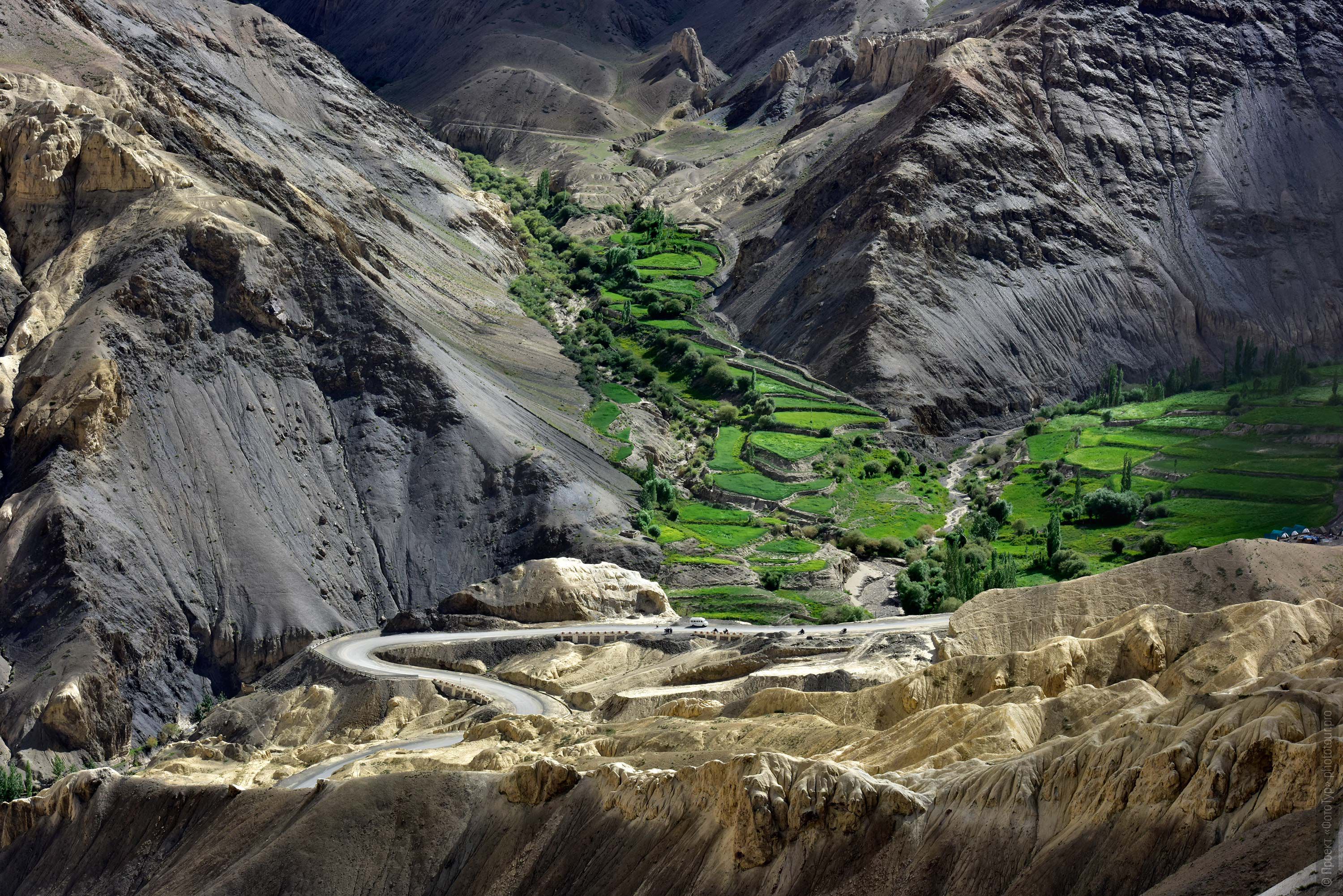
And here at this height our Ladakh Defile will pass), it is here that we will take photographs of clothing sets made in Ladakh, at the junction of cultures.
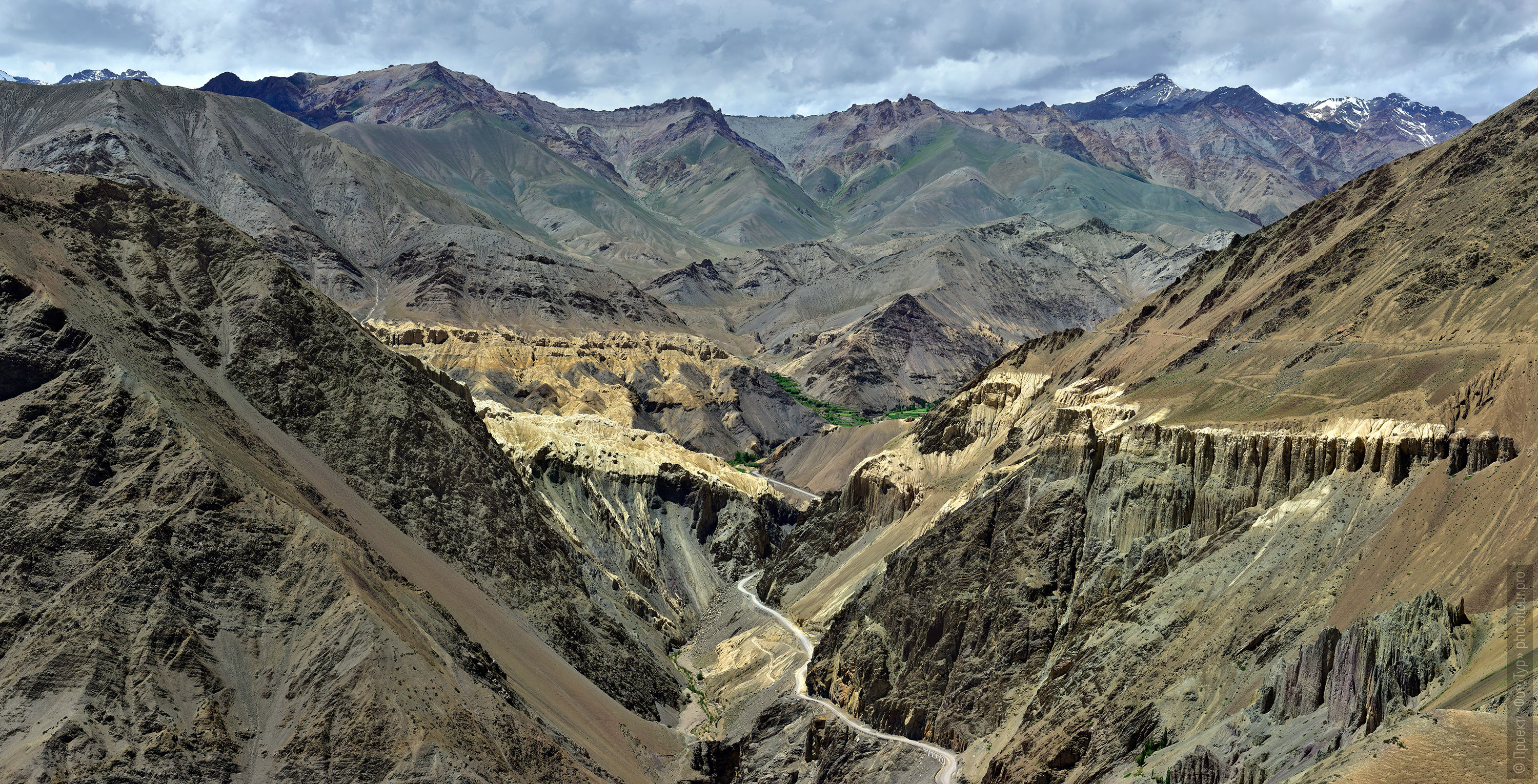
Closer to dinner - return to Leh, and here we will have another vivid impression - we will come back along such a road - it looks impressive, but absolutely safe:

Hotel in Leh.
Day 11, September 10: Leh - Tso Moriri Lake, Karzok, 210 km. Acquaintance with the life of women of nomads Chong Pa.
Day heights: Leh (3,700 m) - Yalung Nyalung pass (5450 m) - Karzk village (4,400 m).
Today we are climbing to a great height, but this height is absolutely safe for us - we have already passed full acclimatization.
We are going on a long and intense road, now up the river Indus.
In general, this is what, and there are always incredibly many impressions and emotions in Ladakh.
Today we will meet with the alpine lake Tso Moriri, we will have a beautiful and long road with stops:
The nature here is so beautiful that it is impossible not to stop at least for a while.
At one of these stops, we will have a picnic lunch in the nature of the Indus River, for example, in such a place.
We will have a picnic with our Ladakh music and dancing.
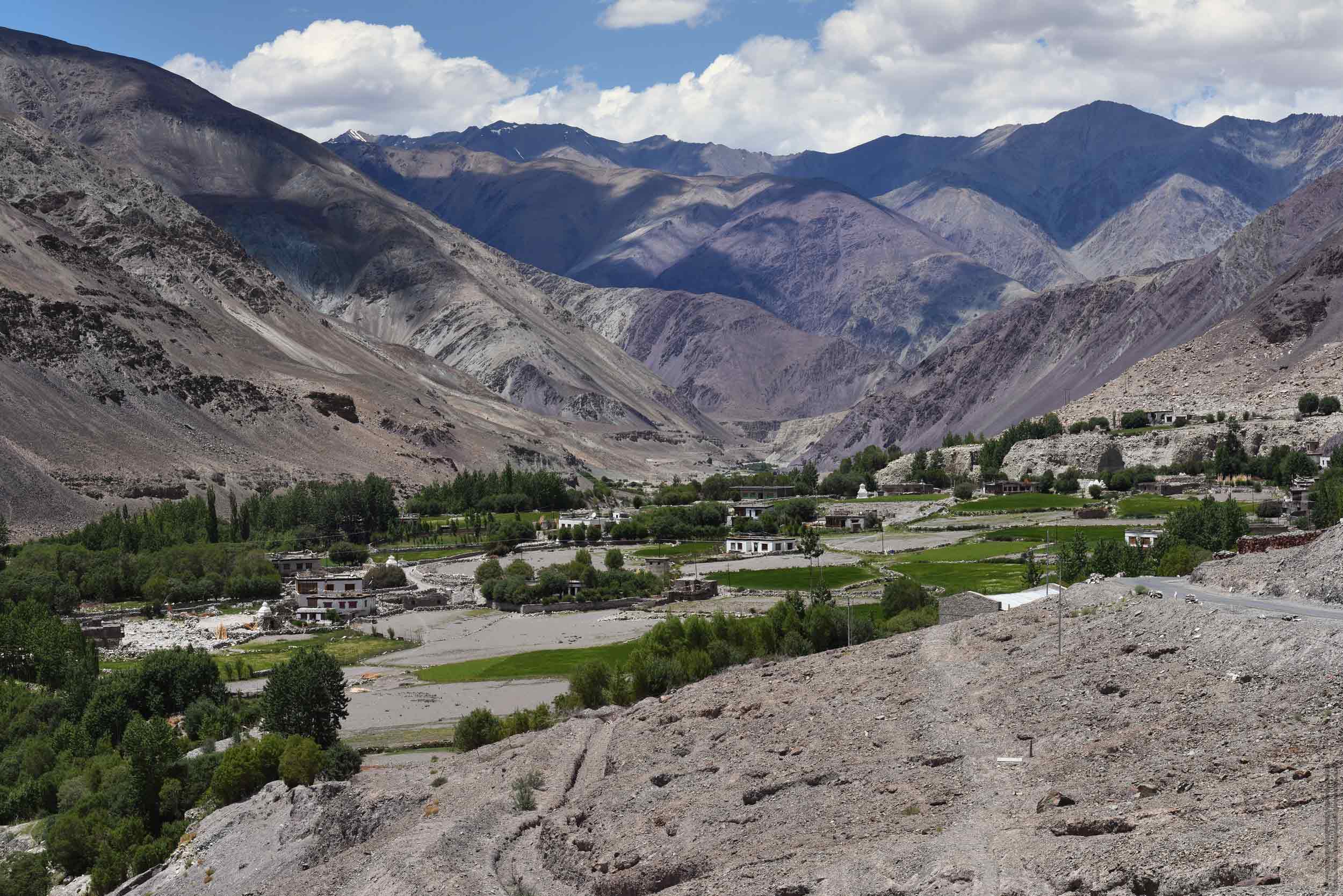
Next, we will overcome the Yalung Nyalung pass (5450 m) and the dusty Rupshu plateau.
From the pass, we will have a view of the lake Kyagar Tso, unrestrainedly blue in color, like the precious eye of aquamarine in the rim of brown coasts.

And after another 17 kilometers - a long-awaited meeting with Lake Tso Moriri.
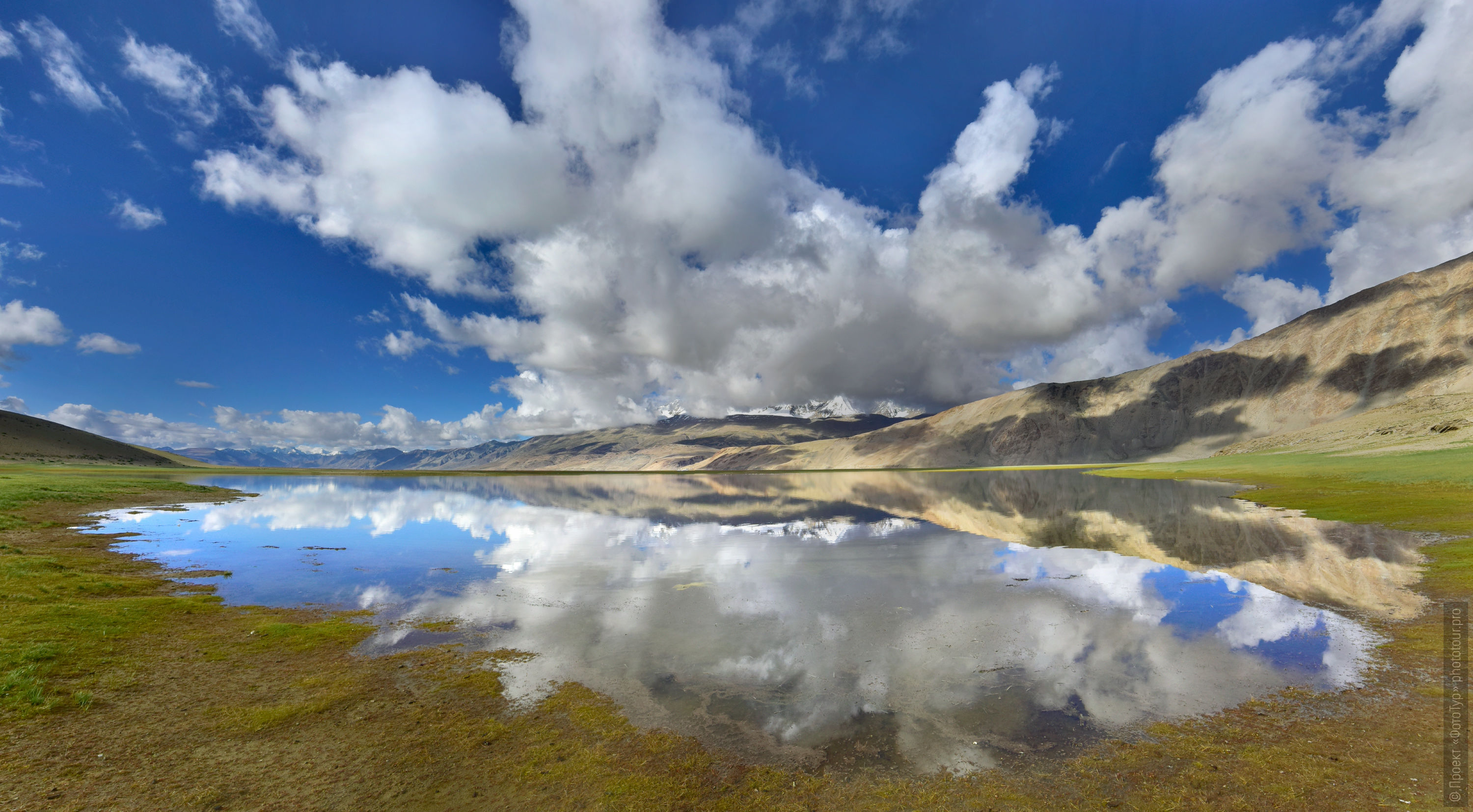
Tso Moriri, Tsomoriri, Tso Moriri - the largest alpine lake in Indian Tibet, 215 km south-east of Leh at an altitude of 4595 m above sea level.
The maximum length of the lake is 19 km, the maximum width is 3 km, and the maximum depth is 40 m.
This is the largest alpine lake in the trans-Himalayan region within India.
The lake water is slightly salty. The lake is available only in the summer season.
Until 1959, the locals were engaged in salt mining (zokar, in the local language Ladakhi) from the lake.
On the shore of the lake is the Monastery of Karzok Gompa and the village of the same name Karzok, where we are going.

Lake Tso Moriri is a beautiful, remote, quiet place.
In calm weather, Tso Moriri is shaking his mirrors:
the world really becomes double, dual, and this ambivalence of the surrounding reality is literally physically felt.
Sunset evening mirrors on Tso Moriri are simply amazing.
Tso Moriri is the most beautiful of the Ladakh lakes.
View photos taken on Tso Moriri Lake in our photo gallery here:
Lake Tso Moriri (Tso Moriri), Ladakh, Himalayas.

We come to Karzok, stop at a wonderful hotel on the lake and go to visit our wonderful Amali, the nomadic women of Chong Pa, drink tea and have dinner.
Hotel on Lake Tso Moriri.
Day 12, September 11: Tso Moriri Lake. Visit the settlements of nomads Chong Pa and herds of Tibetan yaks. Photographing costumes Ladakhskoh Defile, about 30 km, height 4 000 - 4 400 m.
Today we will spend the day traveling around Tso Moriri Lake, and visiting the nomads of Chong Pa.
In a sense, we came here just to the nomads, to meet with the yaks - the yaks are very woolen and warm and are found only at an altitude of more than 4,000 meters, below them it’s just hot.
We walk among the yak nomads, watch their life on pastures, check the wool, agree with the nomads about buying wool for felting.
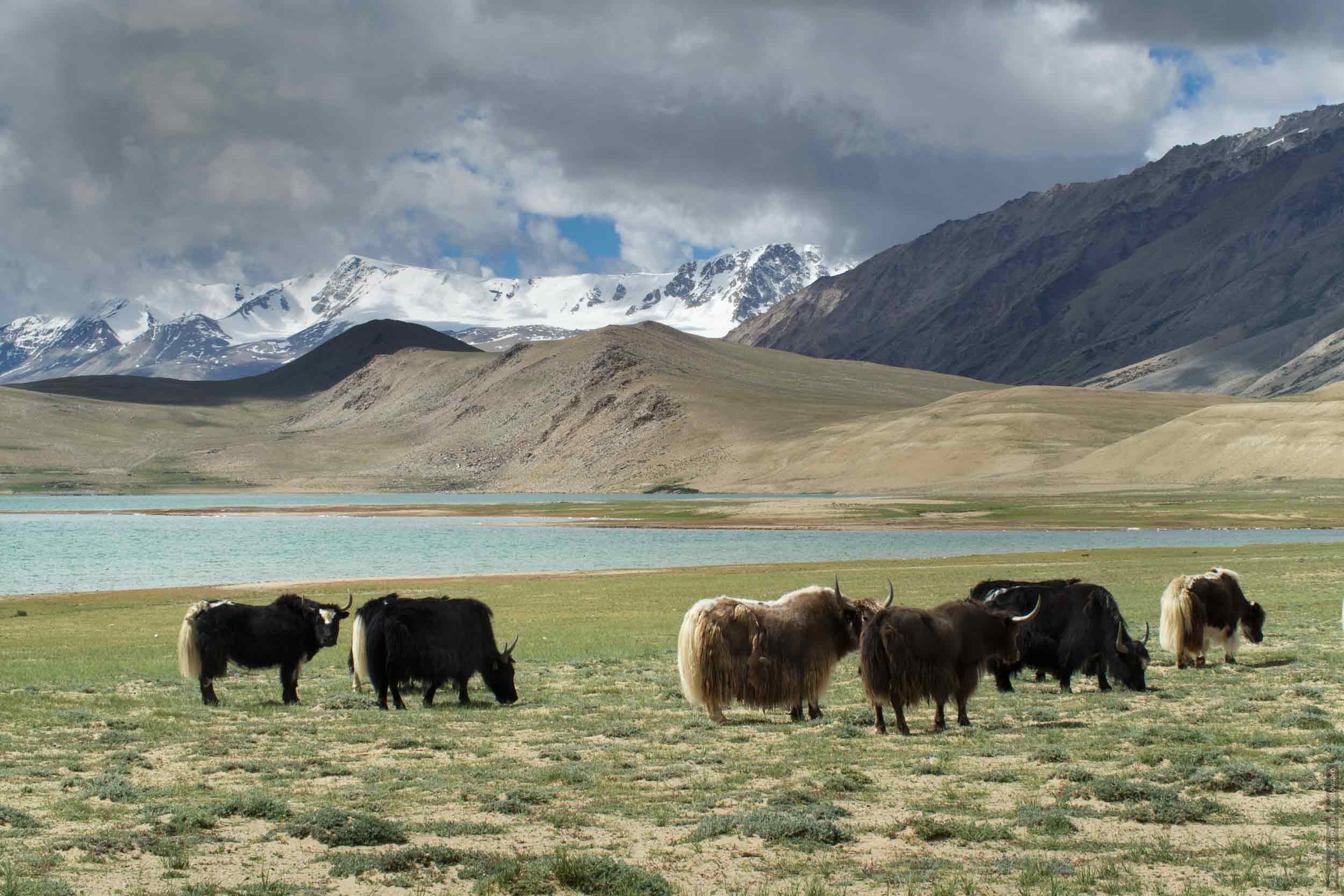
Among yaks - such handsome men are found - just enormous:
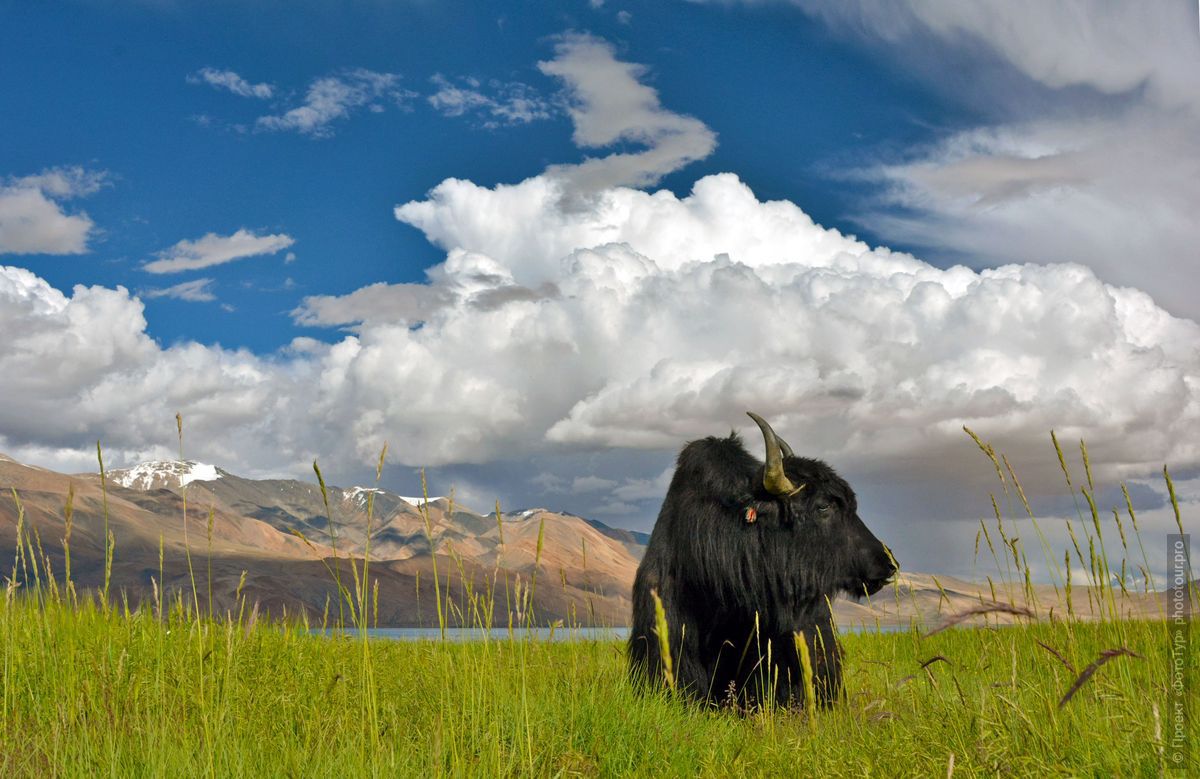
The rest of the time - we are traveling around the lake, maybe we are lucky - and the chance is great, the weather in early September at Tso Moriri is very calm and we will see a full mirror on the lake:
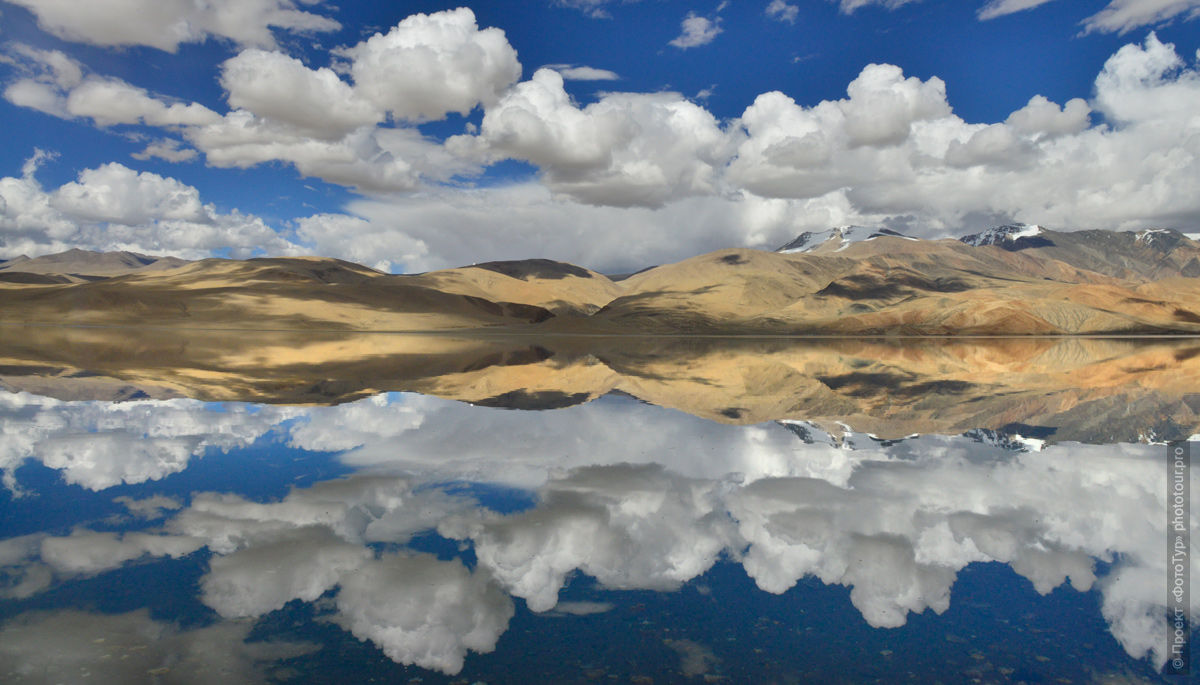
We walk in the floodplain of the lake, where there will be mirrors in numerous puddles in any case, we finish sets of Ladakh Defile costumes.
And the traditional evening walk on the Tso Moriri Lake:
on the far shore of the lake we hang Buddhist prayer flags and build on a small mortar -
they say that if you make a wish while doing this, it will come true.

Hotel on Lake Tso Moriri.
Day 13, September 12: Photographing of the Ladakh Defile costumes at Tso Kar Lake. Return to Leh.
Karzok - Valley of Geysers - Lake Tso Kar - Valley Rupshu - Burgundy Gorge - Leh, about 287 km.
Day heights: Karzok (4,400 m) - Valley of Geysers (4,500 m) - Tso Kar (4,600 m) - Burgundy Gorge (4,000 m) - Lech (3,600 m).
A very early ascent and today we return to Leh, but we are returning on a completely different road — across Lake Tso Kar and the valley of high-mountain hot geysers.
A very busy day is coming today - we will see so many incredible places and landscapes within 14 hours.
So:
1. Just 17 km from Tso Moriri Lake there is a small beautiful lake Chiagar Tso.
Our first stop on this day is here.
If we are lucky, herds of horses will roam on the shore of the lake, usually on these holidays, nomads drive their horses here.
Or yaks, if you’re really lucky.
Short walk along the lake shore.

2. Valley of high mountain hot geysers.
Yes, it is on the road from Tso Moriri to Tso Kar that we will visit a unique alpine valley of geysers, located at an altitude of about 4500 m.

The geysers here are very different: from small ones gurgling with huge bubbles to hot glowing fountains of geysers over three meters high.
The Valley of Geysers in the truest sense of the word is a completely fabulous place:
here the climate changes dramatically under the influence of hot springs and in the middle of the highland desert of Ladakh suddenly appear green alpine meadows mixed with salt marshes, the slopes become the brightest colors.
Yellow - exits of crystalline sulfur, among which transparent ammonia crystals, brown, green peels of salts hide.
What is there just not:
egrets, which live in enormous numbers on the shores of the valley, small gurgling springs - very textured photographs are obtained, and, naturally, geysers-fountains.
In the springs you can also swim, and not only possible, but the sources are considered healing, so do not forget to take bathing suits with you on tour.
The geysers themselves give beautiful bright drawings - paintings.
3. Lake Tso Kar. The most charming and continuously-volatile of the lakes of Ladakh.
Tso Car Lake is a very strange place:
here it is impossible to fix the reality - everything is constantly changing, the reality here in the truest sense of the word has the property of fluidity.
Flowing-melting clouds in the sky, the illumination is constantly changing, and with it the color of the lake, the reflections, the colors of the coastal sediments - the salts, the salts are multi-colored.
And even a small vegetation - mosses, we will see flowering mosses - also not catch, to fix the shade.
On Tso Kare it is strange - you can’t find another word, it is strange - the lake is too alive, it is difficult to perceive it as a lake, it is a kind of huge living organism.
And yet - staying on Tso Kare is like a continuous, leisurely conversation with the lake.

Superficially - yes, a lot of very unusual places with salt crusts on the banks are impressive.
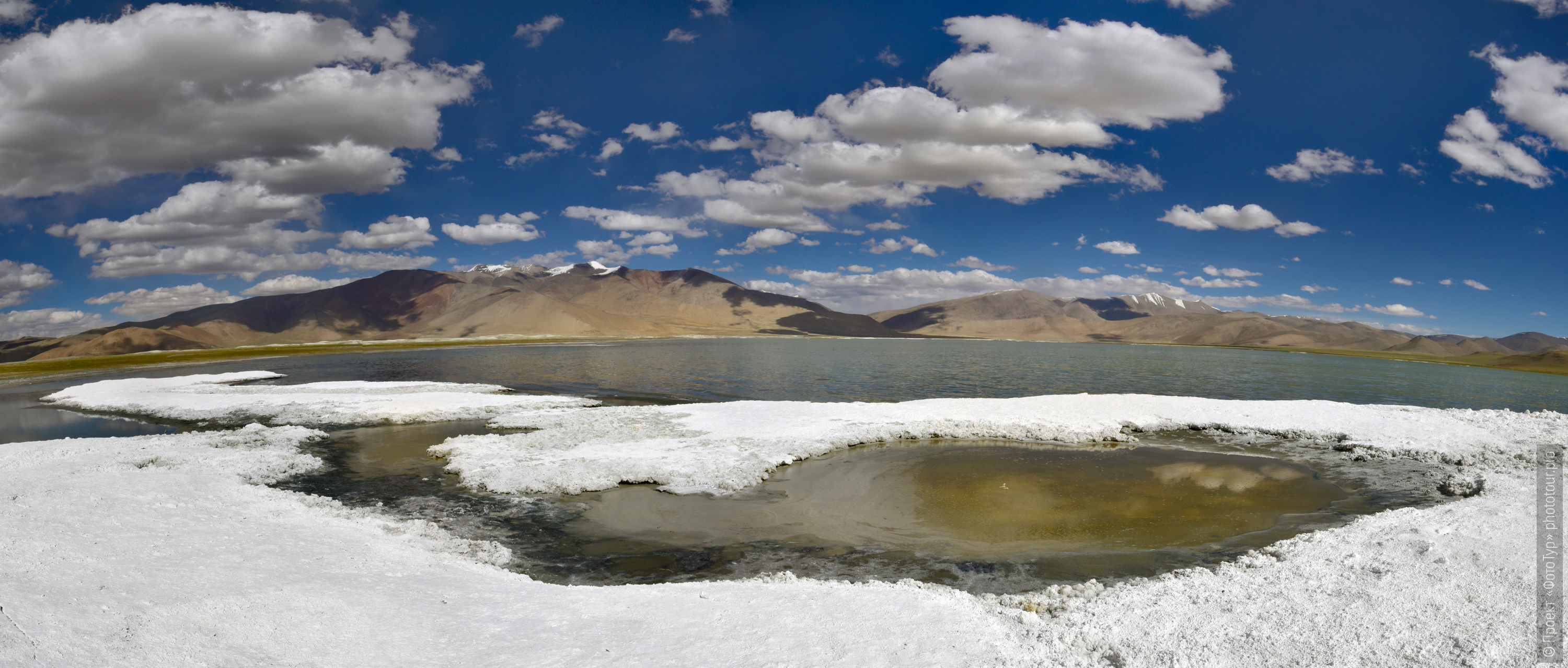
If we are lucky, we will meet with the inhabitants of Tso Kara, for example with numerous high-altitude wild horses here, and maybe we will chase the herd by car:
they love to run a race.

It is worth noting that in Ladakh animals are allowed to come close enough:
in Tibetan culture, it is not customary to harm living suffering creatures, and as a result, creatures here are very open to communication.
4. The dusty valley Rupshu.
After Tso Kara through the dusty valley of Rupsha, we will continue our journey to Leh.
Rupshu is impressive - huge spaces, incredible power of the mountain and in the midst of all this beauty - dusty columns of whirlwinds are raging and walking.
5. Tanglang La Pass, the second highest road pass in the world.
We will go up to the second highest pass in Ladakh - Tanglang La (5358 m), and from the height we will see the high-mountainous dusty valley of Rupsha, which we just passed through.
Here the words are completely superfluous, the pictures in both sides of the pass open, but that’s exactly the way they open.
For example, a view of the valley of Ladakh from the Tunglung La pass.
But it is along this road that we will go down.
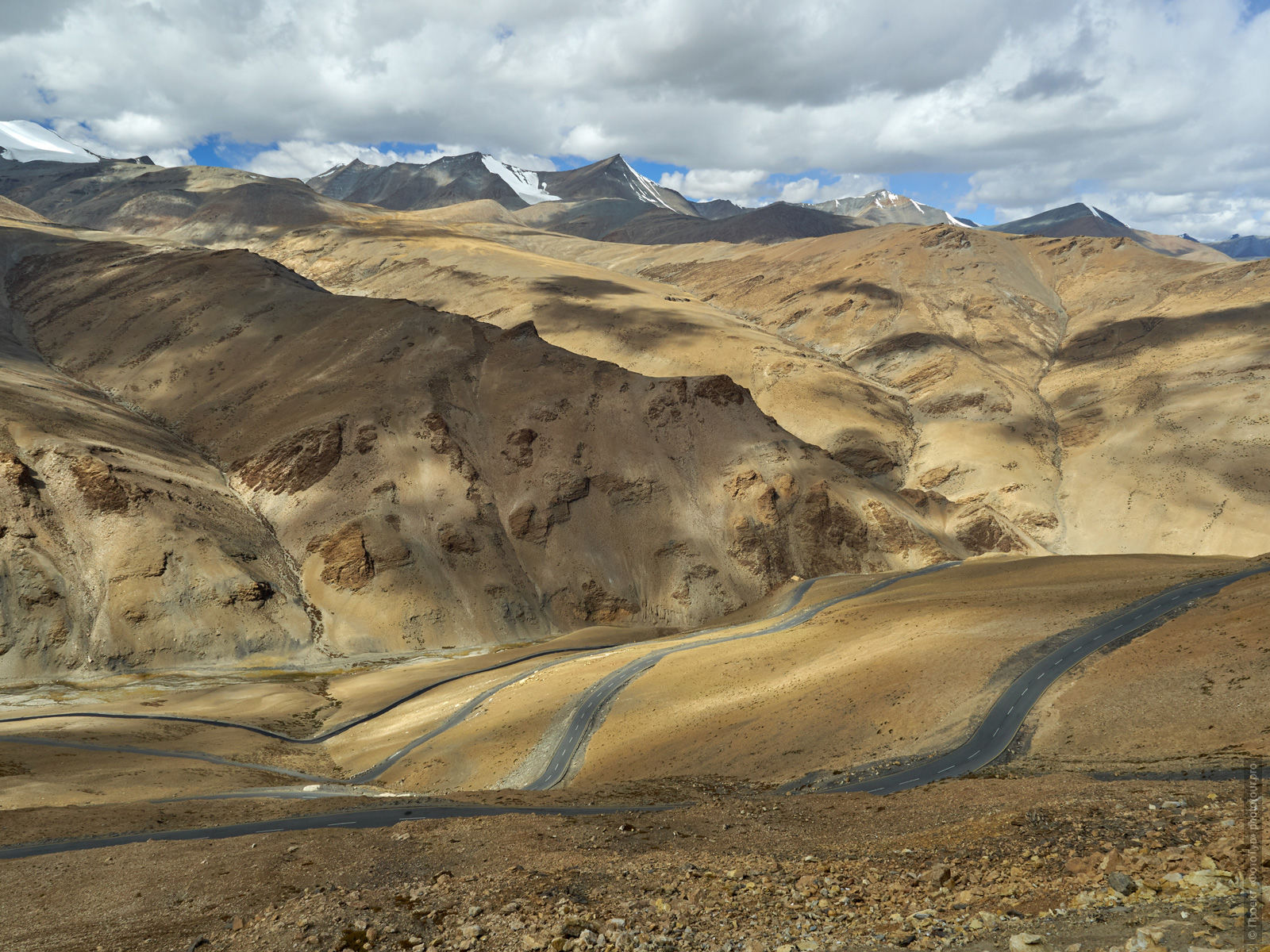
6. Towards evening, we descend to a height of about 4,000 to the Burgundy Gorge.
And this is a very significant event of our tour - we were here at the very beginning of the tour - remember?
And we completed the circle).
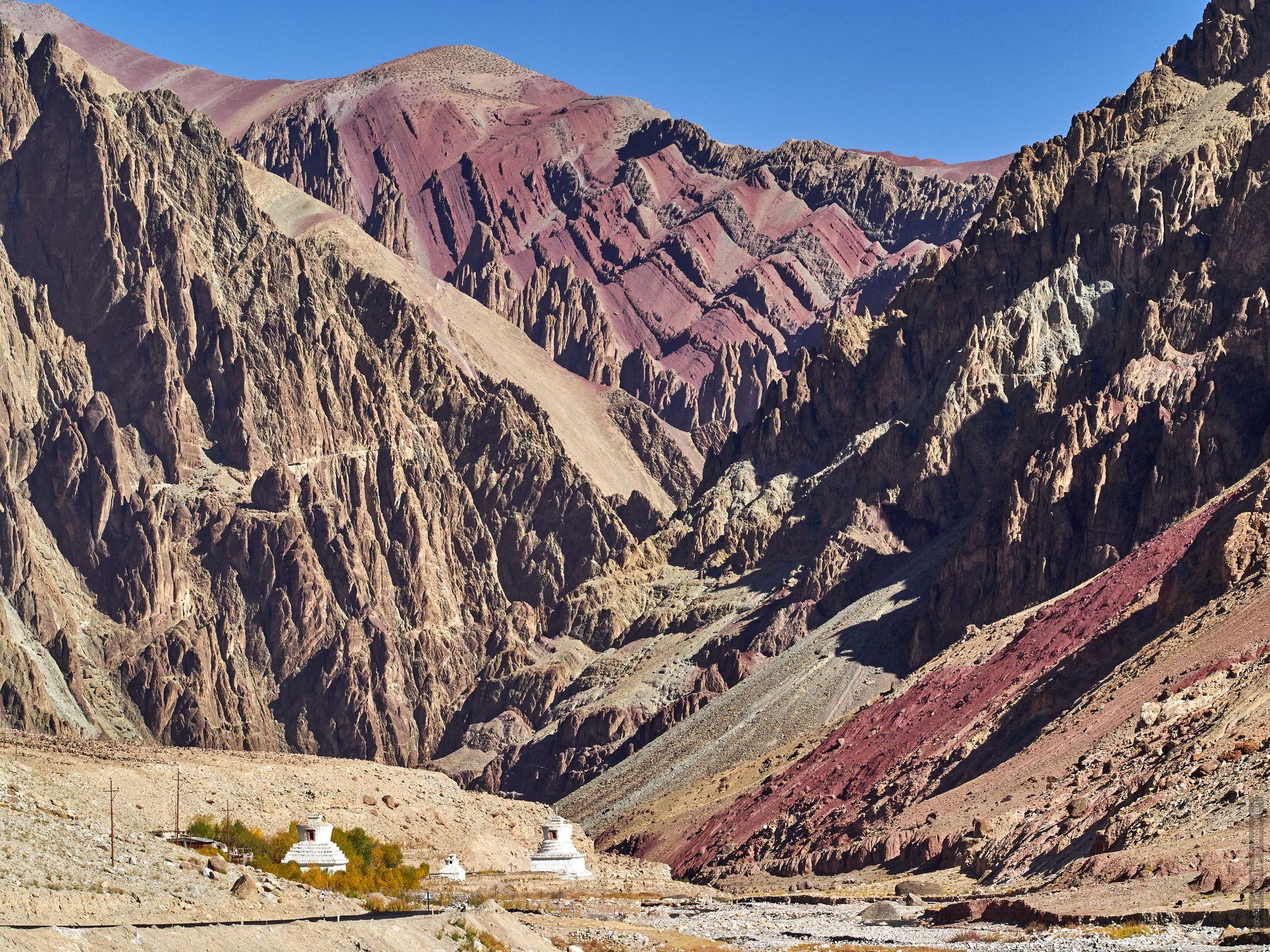
Striving upward, curved into incredible folds, layers of rocks, real stone mushrooms among all this luxury.
And in the midst of all this - white Buddhist stupas, a monastery in the rocks, a small village Rumtse.
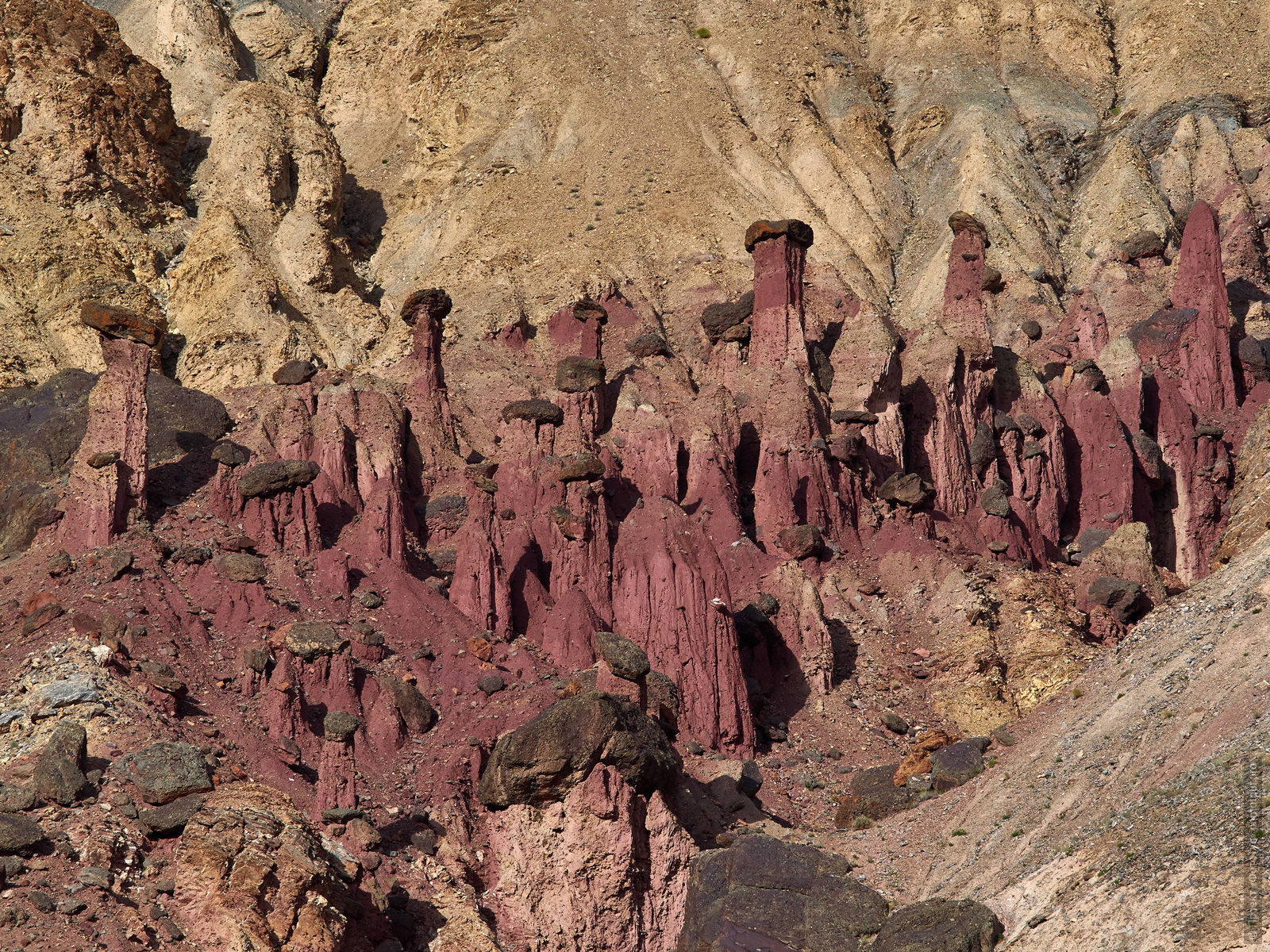
Along the Burgundy Gorge, along the already familiar road, we descend to the Indus Valley and return to Leh.
Hotel in Leh.
Day 14, September 13: Free day in Leh: sum up and buy stocks of wool.
The final day of the tour:
we sum up, we buy stocks of wool with us, we shop - we buy presents for our relatives and friends.
Hotel in Leh.
Day 15, September 14: Transfer to Leh airport. Flight Leh - Delhi. Homecoming.
Early in the morning - transfer to Leh airport, flight Leh - Delhi.
And again we will sail and fly over the grodines of the Ladakh glaciers.
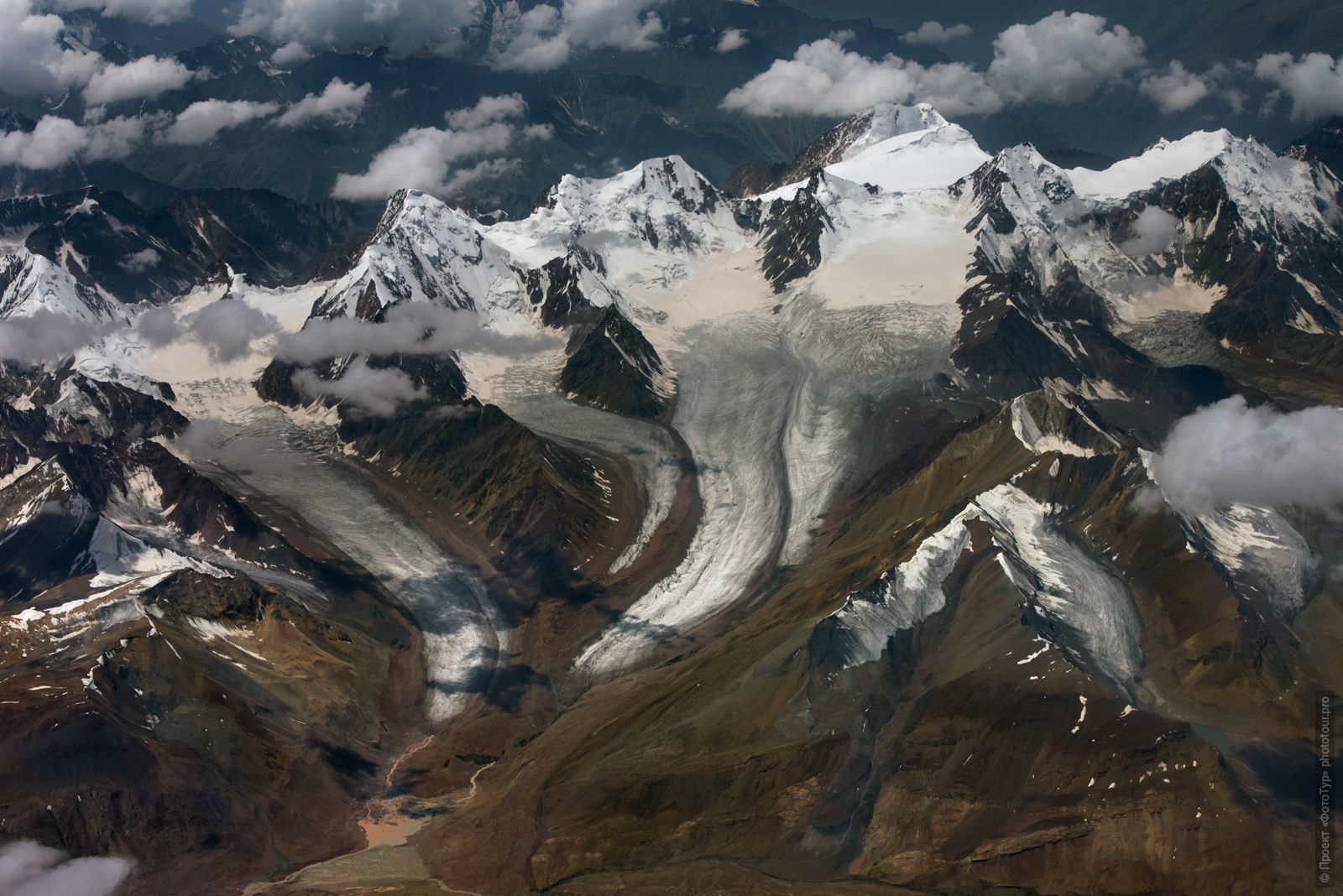
And a little moment:
This is a pilot tour, we hope that in subsequent years, Marina’s creative workshops and tours will become permanent in Ladakh).
And for this there is everything: the sun, the air, a very creative culture and the mass of the very different wool).
But now is not about that, but about the fact that the tour is a pilot one and we are leading it for the first time at a promotional cost.
We tried and really want to run this project.
He is really creative and unusual.
We are waiting for you in Ladakh!)))
